#aging all of the costumes to make them look period appropriate
Explore tagged Tumblr posts
Text
all of the love and attention and focus that goes into showcasing subtle details in ST makes me wanna bark like a rabid dog like the production crew do so much crazy shit, like going above and beyond to make sure everything is exactly the way it should be (or exactly the way it Shouldn’t be) and it is so cool. the show would be NOTHING without the effort that has gone into putting everything on screen the way we see it. every detail matters and every detail is important!!!
#i say things#stranger things#I LOVE ART!!! i love the process of art!!!! i love seeing all the work that goes into it!!!#like fuck the content of the show im here for the hours of work they put into#aging all of the costumes to make them look period appropriate#i want that job tbh i feel like it would be super cool to learn the process#of creating and REcreating the same outfit over and over again#and aging it and abusing it to make all the duplicates indistinguishable#anyway now im just in a mood where im mad at ppl who say#that soo much of this stuff is a production error#like do you really think all the folks who work on the show#want to disrespect it like that? do you not think that this show is the duffers' baby?#and they would just go 'yeah whatever' about blatant differences?#thinking abt how many times i was confused/pulled out of the moment#during el and henry's talk in ep 7 bc his appearance changes like 3-4 times#like his hair is different and the clothes fit different and the blood moves around on his face like#if it wasnt meant to be that way they would have put in the effort#to make every shot look exactly the same. dont disrespect the costume and hair/makeup dept like that#dont disrespect artists like that when theyre in their element#this isnt bbc sherlock where moftass constantly disrespected the genre and the audience#and therefore didnt care to make thinngs seamless and allowed constant real production errors to slip thru#like the duffers are in their element these kinds of stories are their bead and butter#they have such a specific image in their minds of what this all looks like#and they enjoy talking about the show and you can SEE how much it all means to them#and how much effort they put into planning and how much they work w production to get it how they want it#do not disrespect their work by claiming it's production errors
1 note
·
View note
Text

Iris Apfel was finally recognised as a great, original fashion stylist in her 80s, when the Costume Institute at the Metropolitan Museum in New York had a sudden gap in its 2005 exhibition schedule. Many curators knew Apfel, who has died aged 102, as a collector stashing away clothes, especially costume jewellery, both couture-high and street-market-low, so the institute asked to borrow some of her thousands of pieces.
When Apfel wore them herself, dozens at a time in ensembles collaged fresh daily, they had zingy pzazz, so she was invited to set up the displays. There was no publicity budget, and her name was modestly known only in the interior decor trade, yet the show, Rara Avis: Selections from the Iris Apfel Collection, became a huge success after visitors promoted it online. It toured other American museums, changing exhibits en route because Apfel wanted her stuff back so she could wear it.
Apfel’s grandfather had been a master tailor in Russia; her father, Samuel Barrel, supplied mirrors to smart decorators; her chic mother, Sadye (nee Asofsky), had a fashion shop. They lived out in rural Astoria, in the Queens borough of New York, where Iris was born.
As a child, her treat was a weekly subway trip to Manhattan to explore its shops, her favourites the junk emporia of Greenwich Village. She was short, plain and, until her teen years, plump, but she had style; and the owner of a Brooklyn department store picked her out of a crowd to tell her so. During the Depression all her family could sew, drape, glue, paint and otherwise create the look of a room, or a person, on a budget of cents – the best of educations.
She studied art history at New York University, then qualified to teach and did so briefly in Wisconsin before fleeing back to New York to work on Women’s Wear Daily. Furniture and fabrics were in short supply during and after the second world war, and Iris began to earn by sourcing antiques and textiles; if she could not find it, she could make or fake it cheaply.
In 1948 she married Carl Apfel, and they became a decorating team: he had the head for business and she the eye. Unable to find cloth appropriate to a period decor, Iris adapted a design from an old piece and had it woven in a friend’s family mill; she and Carl then set up Old World Weavers in 1952, commissioning traditional makers around the globe.
Photographs and home-movie footage from the next four decades showed Apfel, adorned with elan, haggling for one-off items in souks, flea markets and bric-a-brac shops. She is the most decorative sight in each shot, her ensembles put together with complex cadenzas atop an underlying, tailored, structure– they are like jazz – not a statement, but a conversation.
Apfel was the last of those 20th-century fashion exotics who presented themselves as installations. Although she wore a priest’s warm tunic to the White House (President Richard Nixon underheated the place), plus armfuls of cheap African bracelets and thigh-high boots, she was not an exhibitionist like the Marchesa Casati, and, with her vaudevillian comic timing, was far funnier than the imperious Vogue editor Diana Vreeland.
Also, she never ever bought full-price: her many rails and under-the-bed suitcases of couture were sale-price samples, chosen for their cut, fabric, skilled craftwork and colour dazzle (“Colour can raise the dead”). She might wear them over thrift shop pyjamas, or under a Peking Opera costume, with hawsers of necklaces atop. Money could not buy personal style, she said, prettiness withered, beauty could corrode the soul. All that really mattered was “attitude, attitude, attitude”.
Old World Weavers discreetly refurbished the White House under nine presidents, as well as grand hotels and private houses, before the Apfels sold the company in 1992. They retired to a quiet life in their apartment on Park Avenue, New York, its decor an extension of Apfel’s outfits (bad garment choices were cut up for cushions), and in a Palm Beach holiday home where the Christmas decoration collection stayed up all year round, along with cuddly toys and museum-class folk art. Clothes shopping, and the improvisation of an outfit, became Apfel’s daily ritual, as cooking might be to a gourmet.
But after the Met show, and a book, Rare Bird of Fashion (2007), Apfel was back in as much full-time employment as she could manage in her 80s and 90s (she had a hip replacement because she fell after stepping on an Oscar de la Renta gown). She was cover girl of Dazed and Confused, among many other publications, window display artist at Bergdorf Goodman, designer and design consultant – superb on eye-glasses; she wore large, owl-like, frames to stylise her aged face into a witty, unchanging, cartoon.
She took seriously her responsibilities to fashion students on her course at the University of Texas, teaching them about imagination, craft and tangible pleasures in a world of images.
Her career lasted – nothing was ever too late: in 2018, Iris Apfel: Accidental Icon, a book of memoir and sound style advice; in 2019, a contract with the model agency IMG; and last year, a beauty campaign for makeup with Ciaté London. The documentarian Albert Maysles trailed her for Iris (2014), filming this “geriatric starlet” – her term – as she dealt drolly with new high-fashion friends, or laughed at an “Iris” Halloween costume (glasses, a ton of bangles).
She watched as a storage loft of her antique treasures was listed in lots for sale, and as white-gloved assistants from museums that had begged a bequest boxed up her garments; she still had, and wore, the shoes from her wedding. All things, she said, were only on loan in this world, even to collectors. The point was to enjoy them to the full before bidding them good-bye.
Carl died in 2015.
🔔 Iris Barrel Apfel, decorator and fashion stylist, born 29 August 1921; died 1 March 2024
Daily inspiration. Discover more photos at Just for Books…?
30 notes
·
View notes
Text
OPERA COSTUMES NOW SUIT THE ROLE, NOT THE SINGER March 11, 1984, New York Times
Back in 1875 the famous diva Celestine Galli-Marie was about to create the title role in a new opera called ''Carmen.'' In preparation for the premiere, she ordered a suitable costume - one that was supposed to combine authentic Spanish flavor with a romantic sense of the picturesque in a manner befitting a star of the Paris Opera-Comique. Thus first- nighters witnessed Bizet's spitfire emerge from her shabby cigarette factory immaculately attired in a close-fitting frock of canary satin trimmed with black silk ball fringe, a black velvet bolero, and a wide- brimmed hat with ball fringe to match. ''Gypsy chic,'' one might have called it.
Two decades later, when Emma Calvé performed the same role at the Metropolitan, wearing a seedy shawl (her own, of course), the Diamond Horseshoe gasped in disbelief: they couldn't tell Carmen apart from the chorus. Even her tenor, Jean de Reszke, was stunned. Before singing the role of Don Jose, a sergeant of the Dragoons, he had purchased a gleaming pair of boots suitable for a general. Though they weren't aware of it at the time, Calve was helping to usher in a new age.
The concept of stage costume has changed considerably since opera's palmy days. During the 19th century it didn't matter whether the stars played courtiers or courtesans, barons or beggars, so long as they were arrayed in suitable finery. Elegance and opulence were the rule, and every singer of repute owned a personal stage wardrobe from crowns to shoes.
One can only imagine, therefore, the sort of stage picture that resulted when an international cast assembled to sing, say, ''Les Huguenots,'' ''I Puritani'' or ''Der Freisch"utz'' dressed in a blinding assortment of color schemes, styles and decorations. Certainly it was closer to a fancy-dress ball than an integrated production.
''Obviously this practice is discouraged nowadays,'' says Peter Hall, the most recent head of the Metropolitan Opera costume department. ''Productions should be absolutely complete. Moreover, period is often changed by directors wishing to break with tradition, and things become rather heated when somebody comes along dressed 200 years out of date.''
To the Victorians, richness of effect was paramount, hence old-style costume decoration was very fussy, with all manner of contrasting fabrics used in combination with yards of beads, ribbons, plumes, fake gems, and embroidery, not to mention the pleats and tucks that must have been an absolute terror to clean and press.
''Things are very much simpler today than they were at the turn of the century,'' says Mr. Hall. ''While some designers, such as Zeffirelli, look at old portraits and copy those styles exactly, another school will look at authentic styles and re-interpret them somewhat. Last comes the 'self-indulgent' school that says, 'I'm not going to listen to the music anyway - I'll just do what I think is nice. Obviously that is the wrong way to go about it, for in the end the music should be reflected in the look of sets and costumes. I don't think that you can do Monteverdi in space suits. It has been done, in fact, but the result was hardly successful.''
Space suits or not, stage costume has always tended somehow to mirror its own time. Whether Nellie Melba was singing Gilda, Violetta or the Countess in ''The Marriage of Figaro,'' her ''period'' gowns - which were supposed to represent roughly the years 1470, 1850 and 1785 respectively - emphasized the hour- glass figure dictated by fashion at the fin de si ecle. Photographs of Emma Eames as Tosca show her wearing a bosomy costume that is little more than a gored Edwardian morning dress with an appropriate picture hat. Further on in time, Maria Jeritza's Tosca boasted the svelte lines popular during the 1920's and 30's.
Make-up and coiffure also have a lot to do with period feeling, but most singers have tended to wear whatever is popular or flattering. For instance, dark eyelids, kewpie-doll lips and headbands worn low over the brow usually indicate performances of the post-World War I era, whether the role depicted is Tha"is, Lakme or the "Agyptische Helena, and everyone is familiar with the all-purpose hairdo that Dame Joan Sutherland lets down only for mad scenes.
Men have been just as fashion conscious. When large, waxed moustaches were the rage, Caruso, Florencio Constantino, Mattia Battistini and many others sported them even when portraying normally clean-shaven 18th-century characters in powdered wigs.
Renaissance and earlier historical styles gave Victorian and early 20th- century designers the chance to indulge in amazing flights of fancy shackled by considerations of modesty. A copy of Harper's Weekly from 1855 contains engravings of Giulia Grisi and Marietta Alboni as the protagonists of Rossini's ''Semiramide.'' As the exotic Queen of Babylon, Grisi wore a pointed bodice, short puff sleeves, multi-layered skirt over numerous petticoats, floor-length veil and Statue-of-Liberty coronet that were merely outlandish variations on the outfit worn by Queen Victoria to the opening of the Crystal Palace in 1851.
Alboni sang Arsace, a trouser role, in a short flounced skirt worn over voluminous pantaloons tucked into dainty suede-topped boots (to give the impression of pants while hiding her legs) . With her little painted moustache - lest anyone mistake her for a woman - she looked rather like Prince Albert in drag.
Biblical and ancient garb were generally treated more like upholstery than attire on the stage prior to 1920. Old production shots of ''A"ida'' show the singers draped like ottomans in layers of heavy, embroidered fabric that would have caused real-life Egyptians to drop from heat stroke. The traditional get-up for ''Samson and Delilah'' resembled the wares of a Levantine rug merchant.
''Once again, it is the music that governs the look,'' says Mr. Hall who remembered a production of ''Samson'' 20 years ago ''for which I had not paid as much attention to the score as I might have. We designed rough, tweedy things with heavy Sumerian fringes. Then, upon hearing the priestesses' music in Act I, I realized that it calls for silk and flowing drapery.''
Nowadays, some sopranos are sufficiently alluring to make sense of more revealing attire when necessary. Gwyneth Jones, for example, sang the ''Tannh"auser'' Venus at Bayreuth clad in little more than a fishnet. It is still a rare tenor, however, who can portray Radames, Samson or Siegfried bare-chested in the appropriate heroic - or sub-tropical - manner. Indeed, Peter Hoffmann, is the only exception that comes to mind. As Siegmund in the Bayreuth centennial production of the ''Ring,'' he managed to strip to the waist before his battle with Hunding in ''Die Walk"ure'' without looking foolish.
Simplification and a greater striving for comfort and economy have had a marked effect not only on contemporary costumes themselves, but on their accessories. Although Mr. Hall personally favors ''full period costumes using fabrics as close to the original as possible,'' synthetics and substitutes can frequently be more practical and less costly. ''I like wool to be wool and silk to be silk, but obviously things are so expensive nowadays that one can't always do it. Materials that were extravagant at $25 a yard 10 years ago are now $125. It is still more economical to buy leather in skins than the imitations, however. For one thing, imitations can't be cleaned, nor can they be shaped like the real article.''
Stage jewelry and armour tend to be much lighter today than formerly. Old opera crowns used to be made of gilded metal, but the Met usually uses gold kid on a felt or elastic base. ''In Italy,'' says Mr. Hall, ''armour is still often made by property departments using brass and tin. We're inclined to use felt or vacuform (a plastic) with a metalic coating. Jewelry has also been greatly simplified. The old practice was to set false gems and pearls in brass prongs, then to sew the entire setting to the fabric. ''Now we sew on the pearls and gems directly, and apply gold braid afterward to suggest the setting.''
Robert Tuggle, archivist of the the Met, who acts as curator of the historic collection along with restoration consultant Gail Frohlinger, recently commented that, ''Even though luxurious silks and handmade laces have yielded to less opulent fabrics and trimmings, the general level of costumes is higher today than it used to be. The greater attention now being paid by designers to the chorus and smaller roles has fostered productions for which the workmanship on minor costumes is on a par with that given the stars.''
Recalling the violent upheavals that formerly took place when divas and dressmakers disagreed, Mr. Hall observed that there are relatively few donnybrooks in the Met's costume department today because singers are more serious about their work than their forebears used to be. They still have their quirks, however. ''One singer will not permit wool or velvet to cover his chest - only hard satin, because he says his voice bounces off it.'' Another once insisted that his voice was going up inside his helmet and being trapped there - although it didn't cover his face at all. ''So we made small holes on each side - like a rain hat - and he was delighted.'' Some singers avoid certain colors, either due to vanity or superstition, while others take a liking to one color or even to a particular garment. Luciano Pavarotti, it seems, belongs to the second category. ''He has a pronounced tendency to wear his favorite black suede vest in everything,'' said Mr. Hall, ''and you may quote me on that because I'm sure he knows it himself.''
Whether he does know it or not, whether it stems from superstition or from a desire for personal comfort, we can regard the tenor's habit, perhaps, as a holdover from the palmy days, a slender link with those bursting steamer trunks of the opulent past. There have been many changes in the philosophy of the dressing room over the years, but it's nice to know that some customs remain immutable.
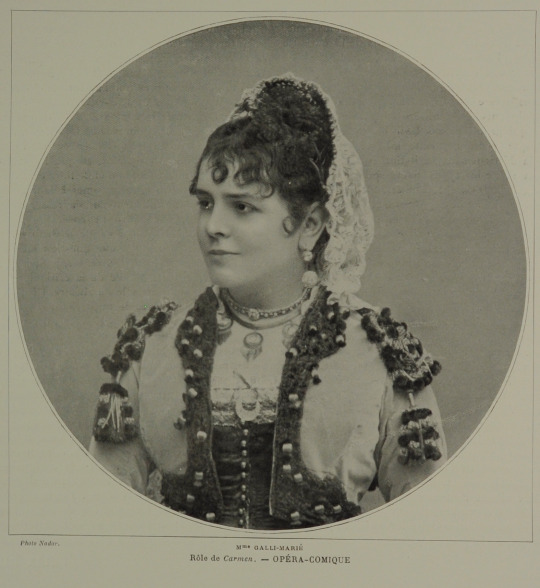
#classical music#opera#music history#bel canto#composer#classical composer#aria#classical studies#maestro#chest voice#Opera Costumes#Costumes#costume design#design#classical musician#classical musicians#classical history#history of music#historian of music#musician#musicians#diva#prima donna#Celestine Galli-Marie#Carmen#Emma Calvé#Tosca#The Metropolitan Opera#The Met#Metropolitan Opera
4 notes
·
View notes
Text
Changes/ things in season 3 that I disliked
the positive season 3 post I made if you would like to read that as well or instead I will be adding both to that post and this one when part 2 comes out
no im not going to talk about the goddamn costumes, everybody has, I agree and im sick of seeing it they look cheap and bad, they need more color they need to look somewhat period appropriate, moving on
We got alot of amazing bonding moments with Ciri and Yennefer but I wish they would have kept the scene where she saved Ciri from the Wild Hunt. We already got lots of Geralt Ciri bonding moments, we needed as much stuff with Yen being Ciri`s mother as we could possibly get and that was one of the best scenes,
(side note of the stuff we did get while I appreciated and “ my ugly one” scene it felt very random and out of place especially with how dolled up they made Freya look, she didnt need to have any makeup on I would have liked to see her more tomboyish look from the books)
TWN usually knocks casting out of the park but Robbie Amell as Gallatin felt so out of place with his acting and trying to hide his accent, and much like the problem with blood origin looks nothing like the other elves and his scar is barley noticeable
I knew he was going to die from when I heard they were going to use an original character instead of Isengrim or Iorweth they really did learn from the Eskel incident. while I didn't like his character his death leads to some amazing character stuff with Cahir, grappling with his sense of self and loyalty to Emhyr since they need to have another reason why he changes sides later because of the age gap between him an Ciri in this version
Dijkstra here just doesn't feel like Dijkstra
normally I don't really care if a character doesn't look exactly like their book counterpart, but Dijkstra being a huge imposing pigish man is part of his character, Graham McTavish isn't doing a bad job, there are a few good scenes and he has good chemistry with Cassie`s Philippa but he just doesn't have the right sarcasm, snark and attitude for the character, even their dynamic is off they’re equally stubborn, arrogant, conniving, and equally think they’re the one dominating the other , book and game Dijkstra stole every scene he was in and was one of my favorite characters this version is mostly boring
( sidenote but I didnt mind the whipping scene it was clearly not meant to be sexual or that they are in a sexual bdsm relationship but that Dijkstra is a Flagellant and that its a stress coping mechanism they engage in as they must trust each other in the underground world)
Tissaia and Vilgefortz being lovers and Tissaia`s seemingly ooc behavior
now to be fair with the intrigue aspect of this season I think they might do a bait and switch with this either Tissaia Is acting this way to lead him on and try to stop him, or Vilgefortz has control over Tissaia in some way ( he is arguabley the most powerful mage in the world even if she also is)
either that or they put them together so it makes more sense for her to side with him/ Nilfgaardian since they established her as much more an active in this version and not just someone wanting to remain “neutral” like in the books
I just hope that her “ending” has as much impact as it should considering what an important character they made her
Episode 5 is a mixed bag
while there were definitely things that I loved about this episode like the tender yenralt moments and the use of dialog from the book, as well as the concept of the framing device from the book, but it got way too repetitive in parts, the Valdo song was fun but it overstays its welcome
this episode reminds me of the Leverage episode “ The Rashomon Job“ while that episode changed things things up every time it went back and told the story from another characters point of view this one doesn't do anything all that creative with it, and your stuck watching a bit of the same exact scenes over and over again with slightly more information
I imagine this episode will work better when the full season out and we see what its all building up to
and I said I wouldn't mention the costumes but, the ball was the one time the consumes had to be really stunning, where is all the color, its so dull looking, why do they look like they are doing a red carpet event in the 90s
and I didn't think it was possible to make Anya look anything less than stunning but this is by far Yennefer’s worst look, it bothered me more than any other visual in the season, nothing works about it, shes supposed to be in a gown with her hair down but she look like a cross between a taky 70s Cher impersonator and a low budget bollywood star
( can some one please draw the TWN actresses in what they are described as wearing in the book like Keira in the green tulle top, Sabrina in the black chiffon blouse and a crimson skirt or Philippa dress lined with diamonds and ermine fur, I will commission you )
the casting of Margarita Laux-Antille completely backfires due to how they wrote her character
Casting a plus sized black woman as a character that is described as white, and extremally conventionally attractive, to spite the gamer dudebros, is a move I like to be clear I love the diversity this show has given us incredible actresses like Anya and Anna and Mimi that in past years would have been looked over
but unfortunately they make her character conform to the “ angry black woman stereotype” and hit Ciri despite her character in the books who could be described as “sweet” and “the cool teacher” hopefully we will see her character more like the books with the lodge in the second half of the season
and just general “sins of the father” stuff that is from the books but isn't given proper context for show only fans to understand
like the discussion about aelirenn leaving out that older elves are infertile, or many things about Aplegatt and his role in the story, the “ my ugly one” line feeling really out of place im sure there is more but thats all I can remember for now,
#the witcher#the witcher netflix#the witcher spoilers#the witcher season 3#twn#review#not tagging critical or negitive dont want to actract those 100% negative#people
3 notes
·
View notes
Text
Celebrating World Book Day with Storybook Character Ensembles
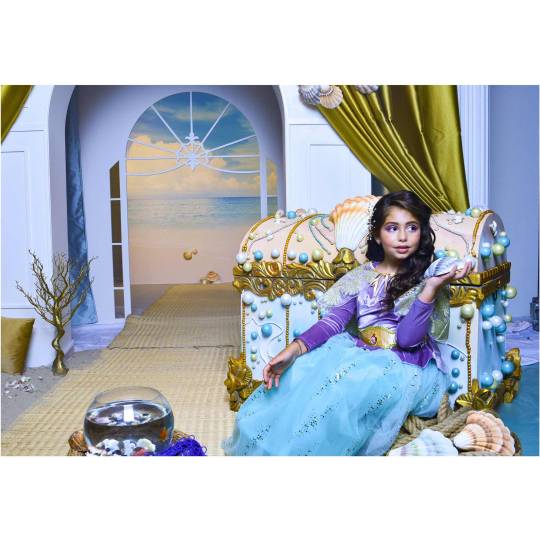
Introduction
World Book Day is not just an occasion to honor the written word but also an opportunity to immerse ourselves in the enchanting worlds of our favorite stories. As we embrace the joy of reading, there's a unique and delightful way to bring the magic off the pages and into our lives – by celebrating with Storybook Character Ensembles.
In a world filled with digital distractions, the importance of promoting literacy and the love of books cannot be overstated. World Book Day serves as a global reminder of the power that stories hold to inspire, educate, and transport us to extraordinary realms. What better way to pay homage to the literary wonders than by embodying the characters who have captured our imaginations?
This guide unfolds a vibrant tapestry of ideas to help you and your community make the most of World Book Day. From choosing characters that resonate with you to planning captivating ensembles and organizing engaging events, we invite you to join us in a celebration that transcends the ordinary and embraces the extraordinary tales that have shaped our lives.
So, whether you're a dedicated bookworm, a casual reader, or someone looking to rediscover the joy of storytelling, let's embark on a journey of creativity, camaraderie, and, above all, a celebration of the captivating worlds that books open up to us. Welcome to a World Book Day filled with the magic of storybook character ensembles!
Choosing Storybook Characters
In the kaleidoscope of literary worlds, selecting the perfect storybook character is a key ingredient for a memorable World Book Day celebration. Here's how you can make the Storybook Character Costumes choosing process an exciting and inclusive experience:
A. Encouraging Participants to Pick Their Favorites
Personal Connection: Urge participants to choose characters they feel a personal connection with or those who have left a lasting impact on them. This fosters genuine enthusiasm.
Diversity of Choices: Emphasize the richness of literature by encouraging participants to pick characters from diverse backgrounds, genres, and time periods. This ensures a vibrant mix of ensembles.
Age-Appropriate Characters: Remind participants to consider the event's audience, especially if children are involved. Choosing age-appropriate characters ensures a family-friendly celebration.
B. Emphasizing Diversity in Character Choices
Cultural Diversity: Encourage participants to explore characters from various cultures and backgrounds, fostering an appreciation for global literature.
Genre Exploration: Suggest characters from different genres, ranging from classic literature and fantasy to science fiction and graphic novels. This broadens the scope and adds variety to the celebration.
Cross-generational Appeal: Consider characters that have stood the test of time, appealing to both younger and older generations. This can create intergenerational connections among participants.
C. Providing Suggestions for Iconic and Popular Characters
Classic Literature Icons: Recommend characters from classic literature such as Sherlock Holmes, Jane Eyre, or Mr. Darcy, invoking a sense of timeless charm.
Modern Literary Heroes: Suggest characters from contemporary bestsellers or modern classics, ensuring relevance for diverse reading preferences.
Iconic Children's Characters: For family-friendly events, recommend beloved characters from children's literature like Harry Potter, Matilda, or Winnie the Pooh.
In the end, the key is to celebrate the vast tapestry of storytelling by encouraging participants to pick characters that resonate with them personally. Whether it's the wisdom of an ancient wizard, the courage of a young adventurer, or the wit of a detective, every character adds a unique brushstroke to the canvas of World Book Day celebrations.
Planning and Preparation
Once participants have chosen their beloved storybook characters, the next step is to bring those characters to life through meticulous planning and creative preparation. Here's a comprehensive guide to help you organize a seamless and enchanting World Book Day celebration:
A. Grouping Participants Based on Themes or Genres
Theme Coordination: Encourage participants to coordinate their character choices based on themes or genres, creating visually cohesive ensembles. For example, have a group of fairy-tale characters, superheroes, or characters from a specific literary era.
Cross-Genre Collaborations: Embrace diversity by facilitating collaborations between participants embodying characters from different genres. This fosters a sense of unity among readers with varied literary tastes.
Age-Group Segmentation: If organizing events for different age groups, consider segmenting participants to ensure age-appropriate interactions and activities.
B. Collaborating on Costume Ideas and DIY Options
Online Workshops: Arrange virtual workshops or discussion forums where participants can share costume ideas, tips, and DIY hacks. This collaborative approach sparks creativity and mutual support.
Costume Swaps: Facilitate a costume swap to encourage resourcefulness and sustainability. Participants can exchange or borrow costume elements, fostering a sense of community.
Budget-Friendly Options: Share cost-effective and easily accessible costume ideas. Emphasize creativity over expense, inspiring participants to craft unique ensembles without breaking the bank.
C. Creating a Shared Vision for the Ensemble
Virtual Meetings: Host virtual meetings to allow participants to discuss and align their visions. This ensures a harmonious and visually appealing group presentation during the celebration.
Collaborative Pinterest Boards: Create shared Pinterest boards where participants can pin costume inspiration, helping each other refine their character portrayals.
Event-Specific Hashtags: Introduce event-specific hashtags for participants to share their progress and ideas on social media. This not only enhances collaboration but also builds excitement leading up to the celebration.
In essence, the success of World Book Day celebrations lies in meticulous planning and collaborative preparation. By facilitating coordination among participants and fostering a sense of community, you set the stage for a vibrant and visually stunning celebration of storybook character ensembles.
Storybook Character Costume Contest
A highlight of your World Book Day celebration can be a spirited and creative Storybook Character Costume Contest. This adds an exciting element of friendly competition, showcasing the dedication and imagination participants bring to their chosen characters. Here's how you can organize and execute a memorable costume contest:
A. Costume Parade
Introduction of Characters and Participants:
Create a lively atmosphere by having a charismatic host introduce each participant and their chosen character.
Encourage participants to briefly share why they love their character or any interesting anecdotes related to their choice.
Showcase of Creativity in Costumes:
Organize a parade where participants can showcase their costumes, allowing everyone to appreciate the creativity and effort put into each ensemble.
Consider incorporating a runway-style presentation or a designated area for participants to display their costumes effectively.
B. Storybook Character Trivia
Fun Facts and Questions:
Prepare a set of trivia questions related to various storybook characters, incorporating a mix of difficulty levels.
Host a lively Q&A session, engaging participants and the audience in a fun and interactive way.
Prizes for Extensive Knowledge:
Award prizes for participants who demonstrate extensive knowledge of their chosen character or exhibit exceptional storytelling insights.
Incorporate book-themed prizes such as book vouchers, literary merchandise, or special editions to add an extra layer of excitement.
C. Reading Sessions
Cozy Reading Corners:
Set up cozy reading corners where participants can briefly share excerpts from the books that feature their chosen characters.
Encourage participants to bring their favorite books, creating a mini-book club atmosphere.
Interactive Storytelling:
Organize interactive storytelling sessions, allowing participants to narrate a short story or engage in a dramatic reading related to their character.
Involve the audience by encouraging questions and discussions, fostering a love for storytelling.
The Storybook Character Costume Contest adds an entertaining and educational dimension to your World Book Day dress up celebration. By combining the visual spectacle of creative costumes with engaging trivia and storytelling, you create an immersive experience that celebrates the essence of literature and the characters that make stories come alive.
Conclusion
As the final chapter of your World Book Day celebration unfolds, take a moment to reflect on the magic and camaraderie that enveloped your community through the celebration of Storybook Character Ensembles. Here's a closing note to wrap up the festivities:
A. Reflecting on the Success of the Celebration
Gratitude to Participants: Express sincere appreciation for the participants who brought their favorite characters to life with passion and creativity.
Celebrating Diversity: Celebrate the diversity of characters and literary genres that enriched the celebration, making it a true reflection of the vast world of literature.
Community Connection: Acknowledge the sense of community that flourished as participants collaborated, shared ideas, and celebrated their shared love for books.
B. Highlighting the Impact of Promoting Reading and Creativity
Fostering a Love for Reading: Emphasize how the celebration successfully promoted the joy of reading by connecting readers with their favorite characters and stories.
Nurturing Creativity: Highlight the role of creativity in bringing characters to life, inspiring participants to explore their imaginative potential.
Educational Component: Recognize the educational aspects, such as the trivia sessions and storytelling, that added depth to the celebration, fostering a holistic appreciation for literature.
C. Expressing Gratitude to Participants and Sponsors
Thanking Participants: Extend heartfelt thanks to all participants for their enthusiasm, dedication, and for making the celebration a vibrant success.
Acknowledging Sponsors: Recognize and express gratitude to sponsors, collaborators, and local businesses that supported the event, contributing to its overall success.
Looking Forward: Conclude with a positive outlook, expressing anticipation for future literary celebrations and the continued growth of a reading-focused community.
In closing, the World Book Day celebration with Storybook Character Ensembles has not only honored the written word but has also created lasting memories, strengthened community bonds, and ignited a passion for literature. As the characters return to the pages, the spirit of storytelling lives on, leaving an indelible mark on the hearts and minds of all who participated. Here's to the enduring magic of books and the characters that make them timeless treasures. Until the next chapter unfolds, happy reading!
0 notes
Photo




Dolly Levi’s gold dress in Hello, Dolly! (1969)
Costume design by Irene Sharaff
This year’s Met Gala would have been the perfect opportunity to recreate this gown or something reminiscent of it. Not only is it period-appropriate: 1890s (albeit the Gilded Age reinterpreted through a 1960s lens for a big,splashy musical), but for the literal minded: it’s gold. Very gold. Apparently the dress has almost 10 lbs of 14K gold thread, as well as Swarovski crystals and rhinestones, to make it look so sumptuous on screen (Some of the gold thread can be seen in the choker Streisand wears).
(Piece of trivia: All the gold made it heavy. When Dolly walks down the stairs at Harmonia Gardens, it has a train. Unfortunately, the train had to be removed for the musical number so that Streisand could do the choreography and the other dancers wouldn’t step on it.)
But you wouldn’t even need actual gold thread to make a stunning outfit. Put a long train on that thing, sweep your hair up and put in a few extravagent feathers, and you’re ready.
Of course the attendees don’t have to interpret the Gala theme quite so literally, but it would’ve been great if at least it had been referenced a bit more than it was. The Met Gala is an occasion where famous rich people can go all out, and the most opulent clothes are the least out of place. Instead, we mostly got outfits that required a long, torturous explanation of how they fitted the brief (spoiler alert: they didn’t) and celebs who didn’t care what the theme was and just wore whatever they wanted/whatever was lent to them (again).
497 notes
·
View notes
Note
Did it ever occur to anyone that Wanda’s Roma background in the comics was BUILT on racist stereotypes? Similarly to M’Baku but also several others. And maybe that’s why the show runners stepped away from that..?
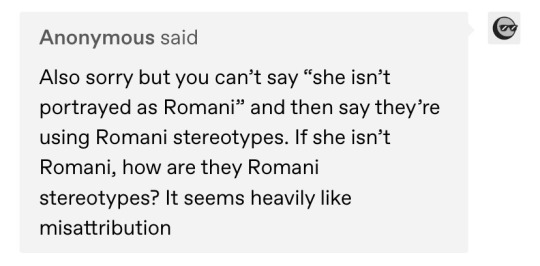
okay, so i think what we have here is someone who skimmed the original post in question (paragraph 2) and likely didn’t ready any of the links attached because that first message has been addressed already... but for anyone else in the same boat:
from gavia baker-whitelaw’s article:
Wanda and Pietro's Romani heritage was canon for decades (including in their non-mutant backstory), although this depiction often had problematic undertones. Wanda is literally a mysterious foreign witch, a damaging stereotype that acquired more nuance in later comics. But instead of updating Wanda and Pietro as modern Jewish/Romani superheroes (much like how Black Panther's charismatic M'Baku started out as a villain named "Man-Ape"), Disney whitewashed them. This casting choice was divisive in 2013, when The Atlantic highlighted the negative connotations of casting a white blonde actress as Scarlet Witch. Roma people are a marginalized ethnic minority, and Disney chose to erase their presence from the MCU.
...This rewrite was rather tone-deaf, because it involved Wanda and Pietro volunteering for neo-Nazi experiments. In the comics, their original parents were Holocaust survivors. Whedon also ignored the most obvious solution to Wanda and Pietro's non-mutant backstory: Django and Marya Maximoff, their Romani parents from the comics.
white washing characters is never the best solution. it doesn’t address the issue in so much as it just sweeps it under the rug. as well as perpetuating the idea that white is some unproblematic neutral that ppl can just default to. like can you imagine if in an attempt to “fix” how m’baku is portrayed in the comics, they just...put a white guy in the role? you can’t just remove a characters racial or ethnic background. no one is saying that her comic background hasn’t been problematic, but this isn’t the way to remedy that.
@scarlet--wiccan has an amazing post about the erasure of this whole family’s ethnic identity in the fox x-men films (x).
@villyns also has a good post outlining some examples of the mcu white washing rather than actually fixing the problem (x).
and here’s a decent article on white washing in media and why it’s a problem (x), quote from this article below:
Making a movie is not an easy feat; there are many things to take into account and even more people that you have to please, but there are also standards and morals to uphold. Whitewashing, blackface, brownface or yellowface is not just about denying jobs to minority actors, appropriating the stories of these groups, perpetuating stereotypes or keeping them invisible, it is about undermining their value as human beings and turning them into stepping stones, props, for white artists.
as for the second part. i think that’s entirely possible, actually. it’s done a lot to characters, where they won’t explicitly state their ethnicity but give them attributes from one (often stereotypes) and make them a caricature without making it, like i said, explicit. take the concept of jewish-coded villains in media. no one from disney has ever said that mother gothel in tangled is jewish, but it’s been pointed out by everyone that she’s jewish coded through stereotypes, ones specifically often used for “evil” witch-type characters, which is no coincidence: large, hooked nose, curly hair, greedy, etc. edit: hollywood uses coding like this often for racial/ethnic groups and the lgbtq+ community.
the maximoffs in the mcu and xmcu have never been explicitly made romani, with disney going so far as to change their parents romani names (django and marya) to oleg and irina. the name changes were unnecessary, except to distance the maximoffs from their original romani identity. the mcu changed their origins stories and cast non-romani actors to portray the maximoffs, and considering they went as far as to remove their jewish heritage as i mentioned before, it’s not a stretch that this is all an attempt to veil their romani background too. while they often joke about stealing and fortune tellers and poverty (the wv halloween episode really put it all in one place, but they’ve been doing it forever in the xmcu and mcu), i wouldn’t say this is an attempt to make them romani as much as it is to use a romani-esque caricature, to use it as a sort of “aesthetic” for the twins without acknowledging that it’s an ethnicity. the aspects they choose to keep are often either negative or painted in a negative light. i think the fact that el*zabeth ols*en continuously uses the g-slur to talk about wanda and costume design, speaks to that.
and even if the mcu came out and said, “oh, our wanda is romani,” that wouldn’t change the fact that she’s played by a non-romani actress (who continues to use anti-romani slurs, despite knowing she shouldn’t) and that so far, they have not explicitly stated in the mcu that she is.
from gavia baker-whitelaw’s article:
Wanda and Pietro's whitewashing feels like an attempt to "neutralize" them. It frames their ethnicity as a problem to be avoided, rather than an opportunity to celebrate an under-represented group. This also meant that Marvel could cast famous white actors instead of sourcing an unknown Romani actor, during a period when the MCU was visibly uninterested in racial diversity.
But Marvel Studios wanted to have its cake and eat it, too. While Wanda is now white and Sokovian, her role isn't completely divorced from its Romani origins. It can't be, because everything in the MCU is informed by the comics. That's how we end up with El*zabeth Ols*n describing her Age of Ultron costume as "kind of this g*psy, vagabond feel"—terms that usually wouldn't come to mind for a simple black minidress and maroon jacket. Wanda's Romani heritage remains visible through veiled references and superficial costume choices, sidestepping any hint of meaningful representation.
from jessica reidy’s article:
Today, some Roma do call themselves witches, and serve as healers and spell-casters in a community, but make no mistake, being a witch is a job like any other. I was trained by my grandmother, I studied hard, I started a business, and I take bookings in my Google calendar. This is the context that most people miss when creating (or, in this case, adapting) Romani witch characters like Wanda Maximoff, and while the Scarlet Witch has plenty of magic, she does not need to fall into the stereotype, nor have her identity erased.
Representation matters. Wanda’s Romani ethnicity has been well-stated in the comic books, sometimes capturing the discrimination and violence that Roma face, and other times falling flat and stereotypical. Marvel also owes us, as Roma are often rendered as mentally unstable thieves, such as Dr. Doom, Wanda and Pietro’s community, and Wanda herself, and the entertainment giant capitalizes off of these stereotypes, reinforcing them all the while.
Every opportunity we get for accurate and positive representation is essential to us because it shapes the way people understand us.
linking the post i made again, because it has a list of articles and posts i’d recommend really taking the time to look through and engaging with them, as well as following folks like jessica reidy and @scarlet--wiccan on social media for more info from romani folks.
699 notes
·
View notes
Text
Historical Accuracy of Costumes in Period Films - Enola Holmes
Disclaimer: I will put no spoilers so you can still read if you haven't seen the movie yet! This post is just me assessing the costumes and their historical accuracy.
First of all, since the movie came out I had already heard a lot about it in just those two days that I was very curious to see if it lived up to the hype and it truly did! It's well-made with round characters and a gripping story line. But enough about the movie, let's get on to the costumes.
The movie is set in 1884, and at first I thought she was born in 84 (because of the intro) so I did like a third of the movie thinking the costumes were outdated until I looked at a closeup of a newspaper and realized that it is set in 84, so yay for me. But anyways, here are the facts.
Enola is 16 years old, therefore considered a child/young woman in society and would be wearing children's clothing but we'll get to that later
There aren't many examples of children's clothing from that time so I'll have to refer to the few fashion plates that I can find.

This blue dress from the beginning of the film has basically everything one would expect from the very end of the 19th century, but not necessarily the 1880s. The loose front is a very end-of-the-century, more so even Edwardian thing, and from the fashion plates and magazines I could find it seems that children's clothing was heavily inspired by adult fashion. It has a very low waistline and is overall very straight. Enola's dress looks more 1900 except for the fitted sleeves which are accurate for the period. And the collar looks completely out of place. But, of course there’s always a but, this is just taking mainstream fashion into account. The Aesthetic Dress movement took place in the 1880s and the dresses would have looked somewhat similar to this one, with a loosely fitted front but they also had puffier sleeves, so it’s like they took some details from different movements and also took some inspiration from the Edwardians and put them all together in a dress.
Another thing I would like to add, (hence the advert - I had to make collages to fit 10 pictures in this post) I am not sure as it doesn't fit her character at all but she looks corseted in those pictures (I added the first one specifically because I think you're able to see the outline of a corset? Faintly?). Depending on your age and status and your parents' plans for you (aka if they wanted you to get married at 16), teens of that age would either wear a corset or not. But taking Enola's upbringing into account and it was rather uncommon for a 16 year old to be wearing a corset, not unseen but uncommon, I'd say that if the costume department decided to put Millie in a corset in that particular scene is historically inaccurate. There were corsets for young women/teens, but they didn't give you that extreme hourglass shape, they were straighter and didn't give you a tiny waist, like the bottom right one in this corset advert. Unfortunately, I could not find out when it's from but it should be somewhat close to the 1880s.
Next up, I would like to say that the length of the skirt they chose for Millie to wear is appropriate for a 16 year old! Unlike what we saw on Anne with an E...

At one point we get a look at her undergarments and they're looking fine for the time! The chemise and the drawers, she's obviously not wearing any petticoats as she's being measured but we saw a glimpse of a petticoat when she was riding a bike in an earlier scene so yes, this part is accurate.

Next up, I'd like to talk about this lady and her dress is just amazing, fashion plate worthy and absolutely accurate, I have nothing bad to say about this.

What I noticed overall in the movie was that the bustles weren't as extreme as I would have expected them to be, but it all had to do with personal preference so it's not necessarily historically inaccurate to see more lowkey bustles. But I didn't see one bustle that was just crazy in today's eyes so maybe they could have improved on that but I'm just nitpicking at this point. Or maybe I've just gotten so used to seeing old clothes that nothing shocks me anymore.
Here we can see some crinolines being sold and judging from their width they are somewhat outdated.
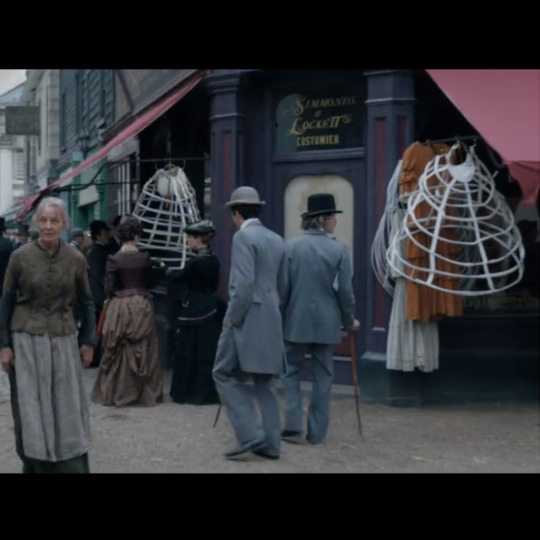
They could pass as maybe early 1870s if not even 1860s.
Now Enola wants to become a lady, so she has to wear adult clothes! Here, she goes into a shop and puts on her clothing. We can see here how poorly fitted the corset is; the lacing gap should be parallel but you can see in the mirror how it gets smaller towards the bottom. Maybe it was done unintentionally but maybe it's just supposed to show that ready-to-wear corsets just weren't made for the person buying them. But in that same scene, we finally get a proper bustle! That's historical accuracy right there!
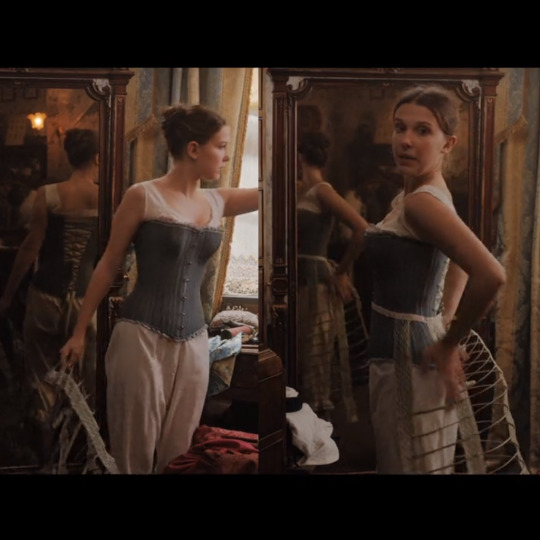
Next up is her iconic red gown.

Now... I had a little bit of trouble with that one. The skirt is a little wide in my eyes, but the overall shape and cut is fine, with that layer draping over her underskirt. However, her neckline is something you wouldn't typically see. You see other characters wear high necklines, so I don't know why they chose to give this dress almost an evening wear look. V-necks did exist in evening wear, but then again they would be paired with frilly short sleeves and not tight fitting day wear sleeves. So all in all, yes, the dress is accurate but the neckline is uncommon.
Next, we have what is probably the most accurate one of her costumes – the mourning gown.
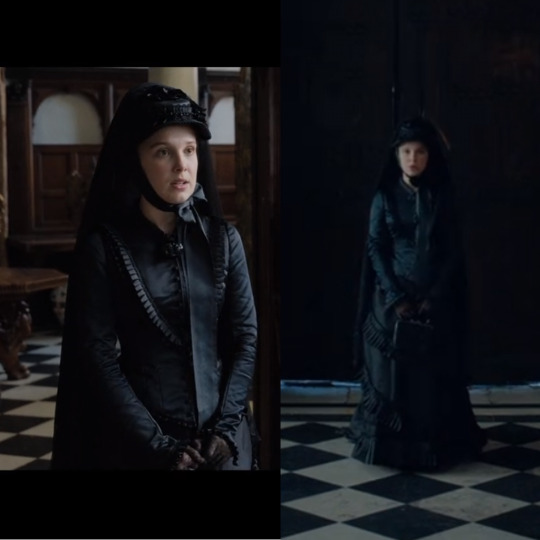
It's slimmer than the red one and there are so many examples of extant garments on google pictures that look so similar to hers that I'm just gonna say, excellent job!
Next is my favorite despite the neckline problem. She just looks so pretty in it!
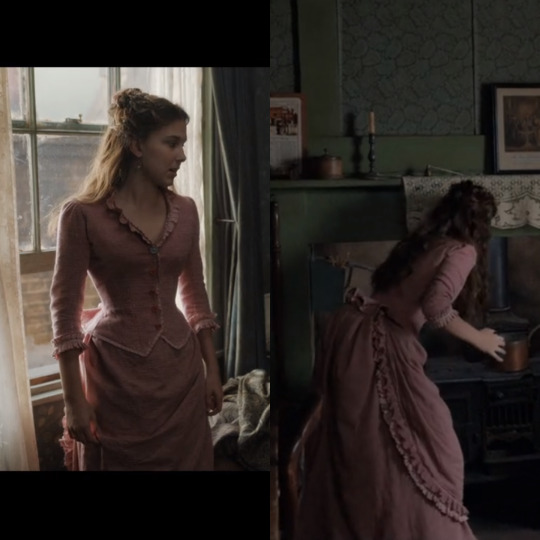
The neckline isn't as low as on the red one but still quite uncommon. Another detail you can see in the second picture is that she seems to be wearing a bum pad instead of a bustle, which I think is acceptable. It's slim, it has a layer that drapes over the underskirt in the front, and even the sleeves are a little bit gathered at the top which was very common.
And lastly, we have this white dress where she goes back to the style she wore at the beginning of the movie.
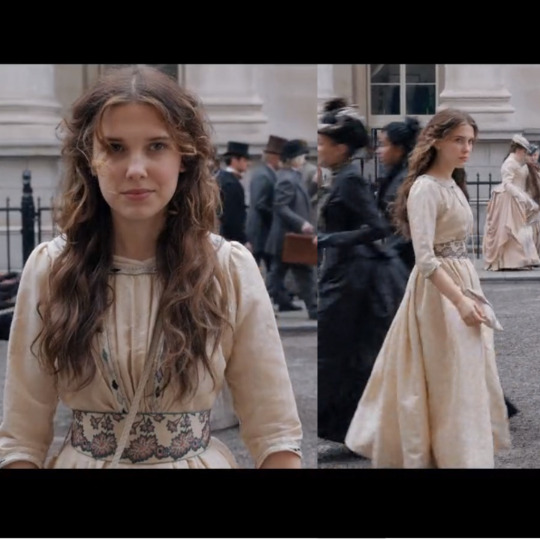
And once again, just like I said in the beginning, this is not something you’d really see being worn in that time unless we’re talking about the Aesthetic Dress and now the sleeves aren’t as fitted so it makes sense for the movement, plus it’s kept very simple.
Overall you can say they did a fairly good job at making everything historically accurate but took some artistic liberties here and there, just like you would expect from a movie.
#enola holmes#sherlock holmes#millie bobby brown#victorian fashion#fashion history#historical fashion#period movies#enola#1880#19th century#1880s fashion#corset#fashion#victorian
1K notes
·
View notes
Text
The "Historical" Disney Costume Rant that Nobody Asked For
To fairly preface this, I am not an expert on Arabian/Middle Eastern culture, pre- or post-Islam. I'm not a fashion historian as in having a degree, only a vaguely passing knowledge and ability to stay up at all hours of the day and night to research obscure topics such as this. However, I am not dismissing or invalidating the feelings of Arabs, Middle Eastern people, or Muslims in regards to Jasmine from 'Aladdin.' I AGREE with them that Jasmine's clothing is neither accurate to the "period" and culture of the Middle East (generally speaking) or appropriate. Jasmine's costume design is viewed through the lens of orientalism, exoticism, and stereotypes of Middle Eastern and Arabian culture.
HOWEVER...
I take issues with this design:
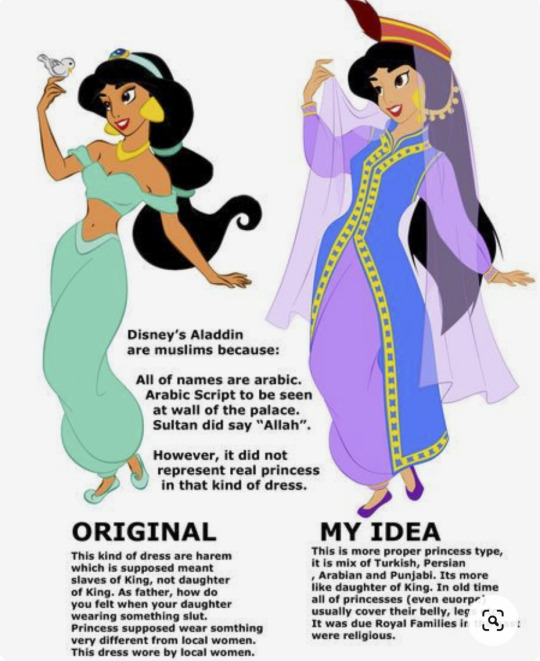
Original Pinterest Post here
Right off the bat, could we not have slut-shamming, please? For five minutes? I understand that 16 year old Jasmine probably shouldn't be exposing that much shoulder and midriff, but that's not a call for slut-shaming. Could we not?
From what I can find, not even slaves or concubines wore the kind of things Jasmine does in any period of the Middle East or Arabia. Her father wouldn't be called "king," he'd either be Shah or Sultan, but that's just a tiny nitpick for me. The meat of the issue for me is the "information" provided between the two figures.
There's not concrete evidence that the characters of Aladdin are Muslims just because they use Arabic names, though some of those names aren't, in fact, Arabic.
Jasmine = Persian (Indo-Iranian dating back to the 5th century BC)
Iago = Spanish
Rajah = Sanskrit
Arabic wasn't invented in the 7th AD. The language is a branch of the Semitic language and emerged around the first century BC. The Arabic word for "God", Allah, is older than Islam. Evidence has shown that "Allah" has been around since at least the 5th century BC. Which makes it entirely possible that use of the word Allah and Arabic names does not definitely indicate that Aladdin takes place after 6th-7th century AD Middle East. Furthermore, I have a suspicion that it takes place much, much earlier than that. Being as old as I am, I have some canon that younger Disney fans might not know. Back in the day (late 1990's and early 2000's), Disney produced cartoon series for Aladdin and Hercules around the same time. Aladdin and Hercules CANONICALLY meet in a crossover episode of their series in an episode of Hercules, "Hercules and the Arabian Nights," which aired in February 10, 1999.
Source 1
Source 2
Since Hercules and Aladdin have canonically met in the same universe, it can only mean that Aladdin takes place in, at least, the Bronze or Iron Age alongside Ancient Greece.

Ergo, the characters in Aladdin do not necessarily represent Middle Eastern or Arabian Muslims from the 7th century AD and beyond. If we were going to set Aladdin in a more "historically accurate," Agrahba would take place in either a multicultural pagan Middle East or one ruled mostly by Zoroastrians, which is equally misunderstood and underappreciated by the West as Islam.
But I have digressed far enough. It kind of bothers me that Jasmine is repainted to be so much "fairer" looking. Not all Arabs or Middle Eastern groups have dark skin, but making her paler to make her appear "better" is...certainly a choice. Furthermore, Arabian and Middle Eastern costumes vary by region, but all are beautiful and colorful.
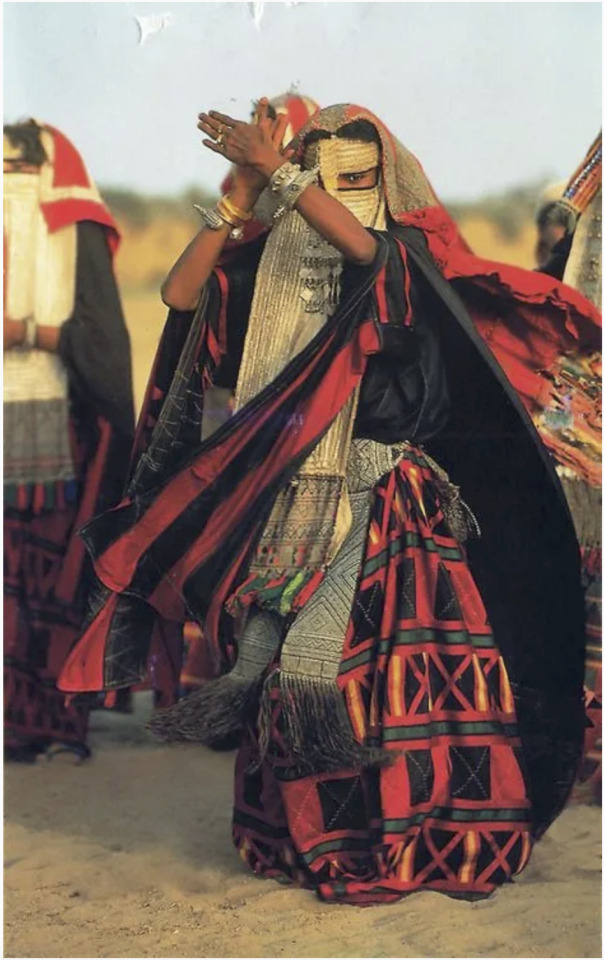
Source
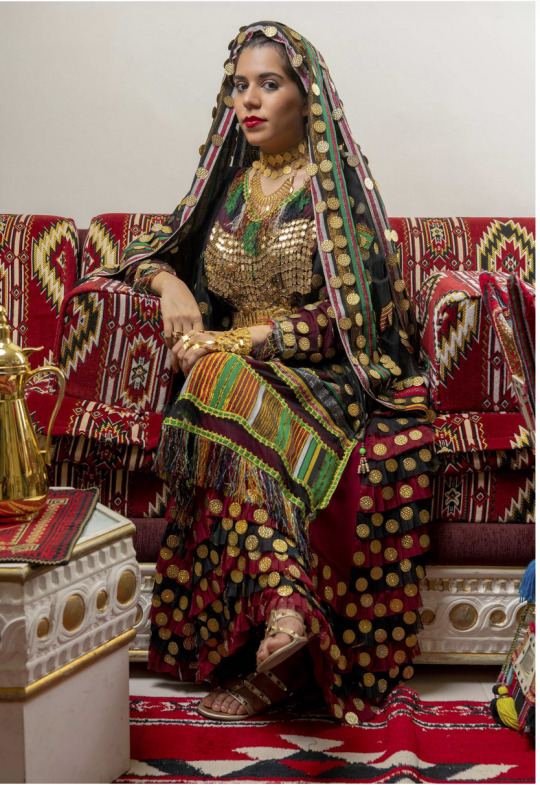
Source
Turkish is not the same thing as "Arabic." For example:
And if we consider pre-Islamic fashion, Jasmine probably would dress more like this:
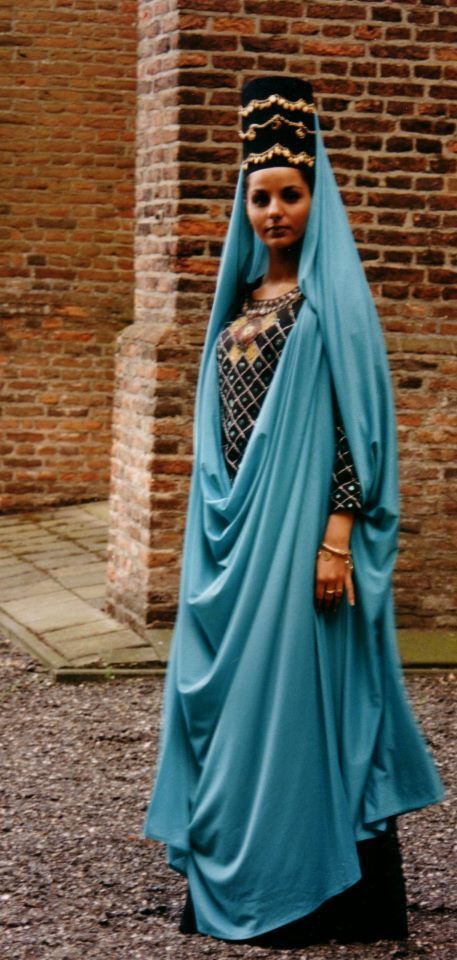
Supposedly, this is a recreation of Parthian dress (Parthian Empire, 247 BC-224 AD).
Combining different cultures such as Turkish, Arabic, Punjabi, and Persian together does the historic costuming of Arabic, Persian, and the Middle East in general a great disservice. The Middle East is not a monolith of culture just because currently it is majority practicing Muslims. Punjab is on the other side of the Indus Valley, and it's Indo-Aryan (not THAT Aryan) in origin, not Arabic. Curious why it's included beyond the fact that many Punjabi today are Muslim.
I'm really not trying to bash the artist here. They have the right idea, but I think with a little more research creating a "new" Jasmine would be far more interesting than pulling from various cultures around the Middle East and Islamic cultures from different regions and slap them together. Thank you for hearing me needlessly ramble coming to my TED Talk.
6 notes
·
View notes
Note
Fic authors self rec! When you get this, reply with your favorite five fics that you’ve written, then pass on to at least five other writers (◠‿◠✿) (if you feel like it!!)
Oh very fun. I can manage a little introspection then. ;D
Admittedly, like most of us, I love all my stories, so this isn't as easy as it seems. I apparently operate under the impression that I can hurt the feelings of my fics so I will tread lightly. ;D
FIDELITY--I have had a lovely time creating the Empire Reimagined universe. I have another mapped out as we speak, waiting for summer so I can properly tackle it. But this courtroom drama fic is dear to my heart. It focuses very heavily on two sets of relationships---Anakin and his two senior officers and Luke and Leia as they strive to save those three. I loved delving deeply into loyalty and the nature of friendship, family and found family. Leia really comes into her own in this fic as well. It was great to brush off my legal brain for the court scenes and I had a fantastic time picturing Luke and Leia facing down several hundred storm troopers on their own too.
A STAR TO STEER BY---
My dear Piett decided he loved tall ships and who was I to deny him a story? So I placed all my favorite Star Wars characters into the Napoleonic period and had a great time letting them fight numerous battles ending with Trafalgar. [Essentially] This was the first fic I illustrated as well and it was delightful to play with period costume for all of our people. Let's face it---the British naval uniform of the period was pretty sharp. And our guys make it look good. I worked really hard to study naval practice and terms from the time. I'm not an expert, but I like a certain level of realism.
SHOWDOWN AT ALLIANCE RANCH---
I know this one was very off the reservation for most people. Star Wars as a Western? Really?
Yep. And I was ok with the niche appeal and small readership. It was such FUN to write! It was one of those stories that really almost wrote itself with all the appropriate tropes. Piett as the good hearted Sherrif. Veers as his faithful friend the Marshall. Leia the ranchowner with a tragic past. The vigilante Vader with his mysterious origins. Evil land baron Palpatine....yeah, I had a blast. The Lady is a horse in this one as is Artoo and the Falcon. No they're just horses, but I tried to get a bit of their personalities in there.
MIRJAHAAL--
A rather long story that began largely because I liked the idea of Piett adopting my OC Matthew Scraps from a young age and them having each other as we went into the original trilogy events [with some tinkering by me of course] It also features Luke and Leia being raised together on Alderaan knowing that their Father is Anakin Skywalker, but having to find out that he is Vader. Zevulon Veers gets to live as well and we follow them all growing up in the Rebellion. I loved the drama and action I got to play with in this story, but most of all I confess to LOVING Piett being a dad with Matt.
REBELLIONS ARE BUILT ON HOPE---
On the Dad theme....
This story was borne of a one shot I did where numerous possible realities showed up in Leia's visions. One of these was her being raised by Piett after the Organas were killed when she was eight. That muse didn't leave me alone and I eventually wrote this full length story. I loved elements like Veers and Piett meeting on the battlefield of Hoth, Vader's choices, and of course Leia being the adopted daughter of Firmus and their sweet relationship.
I also enjoyed adding Ahsoka and Rex more fully into my work for the first time in this story and placing all these characters together for this adventure made for a blast to write.
Thank you for the ask, dear Kanerallels. xxx
8 notes
·
View notes
Text
Diversmagazin Interview Translation
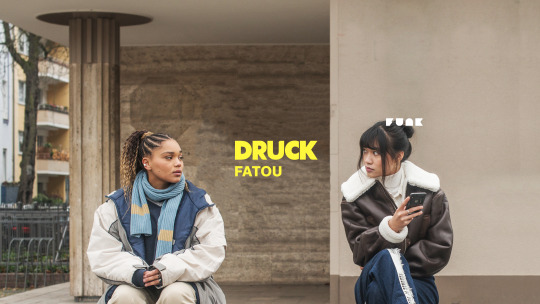
Diversmagazin released an interview with director Sarah Blaßkiewitz and Head-Writer Jasmina Wesolowski today. Read it here in German.
Jasmina (she/her), DRUCK writer since season four and head writer since season six together with Jonas Lindt. In a writers Room with Paulina Lorenz and Raquel Kishori Dukpa (Jünglinge)
Sarah (she/her) director of the last four episodes from season six
I’m leaving out the general introductory questions.
Alicia: Can you talk about the writing process? And what’s the most important thing for you while writing and telling stories?
Jasmina: We especially wanted the profound exchange with young adults who represent our protagonists. For season six we had the challenge that we wanted to tell the lovestory of a Gambian-German girl and a Vietnamese-German girl, perspectives that aren’t represented in the writer’s room. That’s why we talked a lot to research partners, to make up for our lack of knowledge/ experience, but we also talked to the actors and actresses.
Alicia: Why do different directors work on DRUCK?
Sarah: We try to produce as much in real-time as possible. And of course, we have to pre-produce but still have to work [overlappingly]. While one director is already in the editing phase, the next one already starts to shoot. Another reason is of course, that this way, also in the writer’s room, there’s more space for diversity.
Alicia: It’s similar to the writer’s room. You’re also dividing the writing of scenes between different people. … Are you working together with racism and LGBTQIA+ experts?
Jasmina: I think we all have blind spots and that it’s absolutely impossible to end up with a perfect result. It was an important first step, that the Jünglinge collective joined. They are big advocates for queer BIPoc representation in German media. They were always present for feedback loops and made all of us, crew, actors and actresses, participate in an anti-racism workshop. We were lucky to have the brilliant author and anti-racism trainer Arpana Berndt, who advised us on these topics. On top of that, we did a lot of research on different topics. I think now it should be the only way to produce movies and shows this way, with an intensive research phase. This way you don’t appropriate the stories of others and also don’t tell inauthentic stories or, in the worst case, use hurtful clichés/stereotypes. It was helpful and needed that Black perspectives were present also behind the camera – Sara as a director, but also in the social media team, make-up department or costume design. But we are also aware that more can be done.
Sarah: It’s important to me to highlight the make-up and costume design department. When I, an afro-German person, joined this project and met other afro-German women in those departments, who can relate to me, the character of Fatou and Ava, I was really glad. I can say from many years of experience that that’s not a given.
Alicia: How about experts on LGBTQIA+ issues?
Jasmina: To talk a bit about the process: We were set on Fatou being a lesbian pretty early on, and that was already discussed in the earlier writer’s room, where that perspective wasn’t present yet. In the beginning, those were loose ideas, and we had to implement them with the casting. The casting team Raquel Kishori Dupka, Melek Yaparak and Angelika Buschina worked closely with the directors and contacted different institutions and specifically asked for actors and actresses who could be queer. At this age this is of course a super sensitive topic. You don’t want to force young people to [define themselves/come out]. It’s a huge challenge to handle that with care and it was extremely important that the Jünglinge collective was part of the casting process.
But also, apart from the casting process, we profited a lot from the queer people in the writer’s room in the cast.
Sarah: For my part I asked the authors and queer people “What would you like? What is nice? What hurts? What’s important? Or what have I never seen before?” And then I put those different experiences into the different scenes. On top you of course need common sense (?) to portray something that you haven’t experienced yourself.
Jasmin: I just thought of a small really beautiful example: How Fatou was given these rainbow socks as a Christmas present. You immediately notice, that was the idea of a queer person who knows what non-queer parents give to their kids as gifts. The fans notice: Queer people were in the writer’s room. Or “Ah, these actresses know, what they’re doing.“ And those are the small things that make a difference.
Alicia: For sure! In DRUCK you notice that queer people were part of this in really subtle ways, and that [resulted] in really nice fan-moments. I can confirm that.
Right now, the community is discussing the conflict between Mailin and Ava a lot. What role does that conflict play for you and what does it teach us?
Sarah: I’m editing the last episodes right now, so I really feel it, also because you already see the reactions online.
For me, the conflict is important because it shows over a long period of time, that not everything is always only good or only bad. That it takes a lot of time, patience and confrontation to understand all nuances of that kind of conflict.
That Ava could be prevented to outright say what’s bothering her, because we’re talking about a really serious trauma of exclusion. How do you even tell people really personal stuff when you were bullied for years? And now we have that conflict, that seemingly takes forever, and you’re always asking yourself: “Why aren’t they talking to each other?” But it’s only in real time that you realize how hurtful this conflict is. How hurtful it is what they experience. What racism means, and also what it means to [deal] with that topic as a white German girl. And I think it’s really important that everyone is going through that with this season. That takes time and sometimes hurts. And you don’t always understand Ava and you don’t always understand Mailin. When we really [dedicate ourselves to understand this conflict] then I think, we can experience what for example a person like me experienced their whole adolescence. I’m not saying I was bullied my whole adolescence, and maybe it wasn’t because of the color of my skin, but because of something else. But that went on for half a year. After being bullied in school for half a year you’re not up for school and your classmates anymore. And you don’t talk to them anymore. And if people realize that because of this season then I’m glad. I think it’s really touching that this conflict takes up so much space.
Jasmina: I found it really interesting what you said about the nuances, because it was a real process for me to learn how many facets this conflict has. And especially that us white people, who grow up in a society with structural racism, have a particular idea about what racism means. And that’s not a detailed and uncritical perspective of that topic: As soon as you call me racist, I feel attacked and start defending myself.
The role that this conflict played for us was to show how incredibly exhausting it is as a Person of Color, to always have to deal with these problems and that there’s a kind of fatigue, that you don’t want to talk (or should want to talk) about certain topics anymore, especially if you have other things going on in your life on top of it.
On the other hand, we have Mailin, who has a strong desire to understand. She’s not aware of her privileges as a white girl. We want to take this journey together, when she starts to realize things and when she goes through different stages; until she understands, what it is really about. We also have an arc there that isn’t finished. Because in real life, you have to deal with some topics over and over again. We think it’s especially important to show that it’s not the job of Black people to explain racism to their white friends. By now, they have all the resources to educate themselves and to talk with other white people about this topic, to unburden Black people.
Alicia: That’s really interesting! The lovestory of Kieu My and Fatou is an important part of season six, which many queer young adults love. How is the relationship between Fatou and Kieu My representative for a generation?
Sarah: I can actually also see it in an older generation. When I send the cuddle clip of Kieu My and Fatou to my grandpa, he says “Wow, how amazing that a Viet-German and a Afro-German girl are lying in bed together, talk in German and are in a relationship.” This generation hopefully isn’t alone anymore, for example in the sense of: being the only Afro-German person in a small city. That changed and now we see it in that second and third generation. And that’s why it shows me something very real and beautiful.
Alicia: Which scene are you really proud of and why?
Sarah: My favorite scene, and one I’m really proud of and that was really important concerning the pressure of school, was with the main character Fatou. It’s about a path of finding yourself from Fatou and a [Reinigungsmoment] with her brother. Two people, who know each other from the moment of their birth, are sitting together. When I read that scene I thought yes, I can relate, I can feel that, and when we shot that, a world opened for me. And that was partly because of the music, which was decided before we shot this scene. Then we shot it and it was fucking cold, but we shot it again and again but every time we really felt it like the first time. And when I now watch that scene while editing, it really is the perfect moment. Every facial expression is perfect, every reaction. And that’s that kind of truthful (?) moment you’re looking for as an actor, actress, director or author. When everything fits.
(There’s a script for every social media part, What’s App Chats and ideas for social media stories. )
Alicia: When can we expect the next season and what will it be about?
Jasmina: For now, DRUCK is finished and we have to wait how it will continue. Fingers are crossed and of course we’re hoping for a new season.
[Note by me: We‘re not gonna spiral, Jünglinge looked for more writers, Black writers, on facebook a while ago. Nothing is safe but they probably don’t want to make any promises]
#druck#I hope it's understandabl vghghv#It was really cool to hear their thoughts on the mailin ava conflict and bullying storyline
157 notes
·
View notes
Note
Modern Bucky is fat and Steve’s sugar baby. Steve likes to spoil him. :3
eyy only took me a month and a half to answer 😂😂 I'm sorry, nonnie, but I'm highjacking your idea and using it for today's chubtober prompt :D
(I ended up having a lot more ideas for this than I could actually finish writing in time, so this ends pretty abruptly as soon as Steve and Bucky actually meet)
[unfinished] Oct 3: Masks and Malfunctions
Rating: Mature Words: 1911 Relationship: James “Bucky” Barnes/Steve Rogers Additional Tags: Sugar Daddy AU, Daddy Kink, Belly Kink, Weight Gain, Verbal Humiliation, Stuffing, Corsets, Age Gap
Bucky’s phone chimed and he didn’t even have to look at the screen to know that “Steve” just sent him more than enough money for the costume Bucky wanted. He didn’t actually know if that was the guy’s real name, but he’d been funding Bucky’s lifestyle since the beginning of college and Bucky wasn’t about to fuck that up by questioning the guy’s identity.
If this were a normal Halloween party Bucky would have just bought a random costume at Spirit Halloween, but his kinda boyfriend Jonas (it’s complicated) had invited him as a plus one to an actual masquerade ball. Bucky didn’t even know those kinds of things existed outside of fantasy novels, but right now he was at a high-end clothing store getting an “appropriate” costume.
[Bucky] Thank you, Daddy❤
Bucky texted Steve and then went back to trying on another dress shirt. This one had a looser cut that reminded him of something the male love interest in a period drama would wear or a pirate.
“Wonderful choice,” the store clerk told Bucky when he stepped back from the mirror. Bucky would probably never get used to having someone help him pick out clothes, but the higher-end stores Bucky had been to all offered this type of assistance.
“It drapes very well,” the clerk said with a sneer on his face. Bucky turned back to the mirror. Yes, he had to admit he’d fallen victim to the freshman 15. A small belly was rounding out even against the loose fabric of the shirt, but he didn’t actually feel self-conscious.
Steve had complimented him on every single one of those pounds. Bucky probably wouldn’t even have noticed all the changes to his body if Steve hadn’t been constantly talking about them. Bucky had never put much effort into maintaining his physique, but being hyped up by Steve over the smallest changes of his body made him feel desired and his heart fluttered every time his sugar daddy complimented his thicker thighs and soft belly.
“Any other suggestions?” Bucky asked and the clerk scoffed.
“A corset,” he muttered under his breath, but Bucky’s ears pricked up at the suggestion. His first instinct was to text Steve. Bucky didn’t know why it was important for him to know Steve’s opinion when Bucky was going to the party as someone else’s plus one, but excitement stirred in Bucky’s stomach at what Steve might say.
“Sure, get the corset.” Bucky sent the clerk on their way and then sat down to text Steve. He could feel his belly straining against the shirt buttons now that he was sitting down and he snapped a picture of the way the buttons on the otherwise loose shirt were straining over the thickest part of his belly.
[Bucky] Daddy~ they’re telling me I’m fat
[Bucky] they said I need a corset
[Steve] You will look incredible either way.
Annoyance prickled at the back of Bucky’s neck from the generic compliment.
[Bucky] that’s not what I asked
[Steve] You didn’t ask anything.
Bucky rolled his eyes at how literal Steve could sometimes be, but Bucky also didn’t know how to ask for what he really wanted to hear.
Some of his classmates had teased him for his weight gain and instead of making Bucky feel insecure, the hot shame had shot straight to his dick and he’d had to excuse himself to deal with the problem. Since then Bucky couldn’t stop thinking about Steve telling him those things.
Bucky didn’t even know what the guy looked like, but he’d quickly developed a crush just from texting him. It was actually fun to talk. Bucky couldn’t understand how the guy was single when he seemed like this perfect, interesting and kind guy—and rich on top of all that.
There has to be something wrong with him, but so far Bucky hadn’t been able to figure it out. Not for the first time Bucky wondered who Steve actually was, but his thoughts were interrupted when the clerk came back with three different corsets.
All the same material and color, just different cuts. Bucky’s eyes were immediately drawn to the tiny waist cincher—just tall enough to cover the widest part of his belly. Despite his grumblings the clerk helped Bucky lace up the corset and when he looked in the mirror he couldn’t believe it was him looking back.
His entire body shape seemed different. From the billowing sleeves of the shirt emphasizing his wide shoulders to the waist cincher doing an excellent job of making it look like he still had a waist instead of the soft belly that was hidden underneath. The simple black slacks he was wearing completed his outfit. Simple colors, just black and white.
The mask he had chosen matched as well. A deep midnight black that contrasted with his piercing blue eyes and gold detailing that caught the light when Bucky turned his head. He snapped another picture for Steve, but didn’t wait for his response. Bucky could still hardly believe that a single outfit could be this expensive, but Steve of course had transferred enough money to pay for it. On his way home Bucky finally checked his phone.
[Steve] What did I tell you? Incredible.
[Bucky] better than without the corset?
[Steve] This feels like a set-up.
Bucky groaned at Steve’s response. Of course, Bucky would luck out and get the sugar daddy that won’t humiliate him for gaining fifteen pounds before the semester was even over and wasn’t that a personal revelation. Bucky had never thought of himself as someone who could want something like this, but since gaining weight he had become more aware of his body—and how others perceived it.
[Bucky] it is
He quickly pocketed his phone after sending that text. Bucky immediately regretted it. He’d had a good thing going with Steve. Why risk fucking that up? His phone vibrated multiple times, but Bucky was too worried to check his messages until he got home. As soon as he’d closed the apartment door behind him he fished his phone out of his pocket.
[Steve] What does that mean?
[Steve] If you don’t want to continue this arrangement, you can just tell me.
[Steve] Bucky.
[Steve] Answer me.
[Steve] What do you want me to say? That you’re a spoiled pig? That you’ve gotten fat on your Daddy’s money and need a corset to look good for your little boytoy?
Bucky’s throat went dry as he read Steve’s message. The wave of lust that crashed through him, threw him off balance and he sat down heavily on the bench in the entry way of his apartment. He read the message again. And again. His dick gave an interested twitch. It was embarrassing how much he reacted to Steve’s words.
[Steve] Is that what you want?
[Steve] Don’t leave me on read.
Bucky didn’t know what to say. He typed and retyped the same message again until another one from Steve popped up.
[Steve] ‘Yes’ or ‘no’? It can’t be this hard to type one fucking word.
Bucky couldn’t breathe. Steve had always been kind and considerate, it made Bucky’s heart race to see this side of him.
[Bucky] Yes.
[Steve] Thank you, but we will talk more about this tomorrow.
Bucky’s phone chimed to tell him, he should be on his way now if he wanted to get to the party on time. His mind was still caught up in foggy arousal, his cock tenting his slacks. It’s too much, he wasn’t thinking straight and Steve wasn’t even here—wasn’t even touching him. Just a text and Bucky was a mess.
At least the walk to the subway station helped to clear Bucky’s head and chase away some of the immediate, burning need that had been burning in his guts just a few minutes earlier. It left him frustrated, but slightly more level-headed and in a more appropriate mood to be out in public.
When Bucky met up with Jonas outside the high-rise office building the guy was already wasted. He was surrounded by his office buddies and Bucky was honestly about to turn on his heel and go back home when Jonas called out to him. With all his mates there Jonas treated Bucky like another one of them and Bucky was already over the metaphorical dick-measuring contest that was happening whenever one of these guys opened their mouth.
Once they got inside Bucky split off from the group, Jonas didn’t even seem to notice. So, he explored the venue. The party stretched across multiple floors. The bottom floor was full of rich and wanna-be rich people schmoozing and socializing, barely anyone of them had stuck to the masquerade theme and Bucky kept debating whether he should take off his own mask.
He was much more comfortable on the upper floor. There were less people here and most of them kept to themselves. He felt less out of place when he noticed that most of the people here stuck to the masquerade theme, there were only a few people who’s face wasn’t at least partially hidden behind a mask.
Jonas didn’t even shoot him a quick text to ask where he had disappeared to, so Bucky was more than ready to just find whatever food this place offered, eat for free tonight and make the best of the situation. He didn’t know what he’d expected dating someone his age, but Bucky was done settling for anything and he made a resolution to break up whatever was going on between him and Jonas.
When Bucky finally found the buffet that was standard for these types of events, he couldn’t stop himself from loading up two plates and searching for a quiet, secluded place to eat. At this point it had become a reflex to send Steve a text whenever he sat down to stuff himself.
[Bucky] found the food
He sent a picture with his hand next to the plates to give Steve a sense of how big they were. Some guy’s phone went off as soon as Bucky hit send two tables over and for a moment Bucky wondered if that’s Steve.
He had a commanding presence even sitting down. Bucky could tell he’s a gym buff from his ridiculous shape. His shoulders looked almost double the size of his waist. As well as the large plate of food in front of him. This man needed to fuel his body with all those calories, but Bucky was eating more than him and only planning on getting fatter. Bucky dug in.
His little costume went from fitting perfectly fine to too tight within half a plate of food. The corset was throwing a wrench into Bucky’s plan of stuffing himself. He already felt full before he had even really gotten started. The blond guy from two tables over caught Bucky’s eye again. He was frowning at his phone and looking back up at Bucky.
[Steve] What are you doing here?
[Bucky] what do you mean?
Another phone chime from two tables down. Bucky re-read the text two times before he looked back at the blond guy. No way that’s Steve. That would be too much of a coincidence, right? Bucky sent another message and the guy’s phone went off again. For a moment Bucky contemplates just getting up and walking away, but then Steve was already out of his chair and walking up to Bucky’s table.
47 notes
·
View notes
Photo
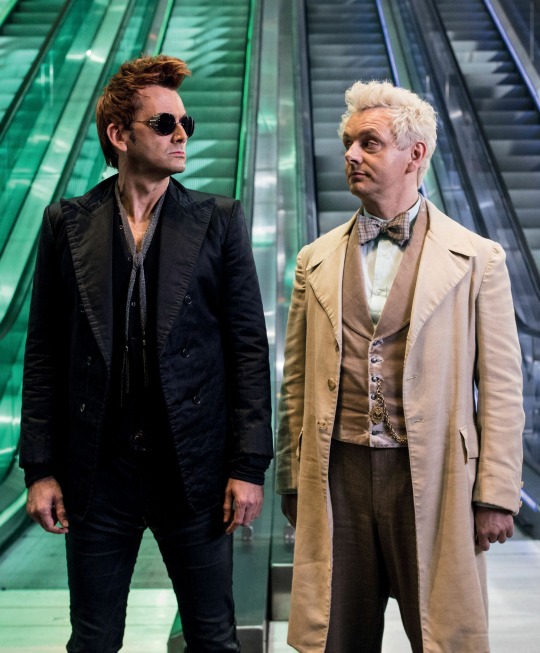
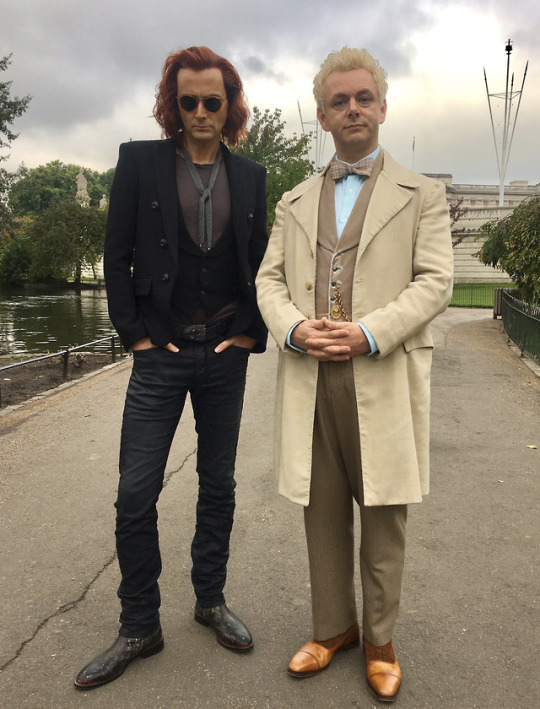
Excerpts from the SyFy Wire & Film School Rejects interviews with Claire Anderson, the Emmy-nominated costume designer for Good Omens:
[ Film School Rejects - by Ciara Wardlow] “I worked through it with gut reaction images. So, two guys. Two guys, kind of close, nearly in love, if you like,” she said. “I just went in and we had a really big, very open conversation about how you related to these people in the script and how we would make them real and plausible, but give them a fantasy element. Give them something otherworldly.”
While Anderson says that she ultimately took this approach with more or less all of the characters, mixing period and modern elements to give characters somewhat timeless, yet also somewhat fantastical “out of time” looks, in the early discussion stages it was all about Aziraphale and Crowley. For one thing, Sheen and Tennant were already cast, which was a major help in determining their looks. It took some time to settle on the duo’s main, contemporary looks, but once these were locked in they played a significant role in determining everything else they wore.
[...] Aziraphale maintains a look with significant nods to the late Victorian era. Crowley too, although he manages to put an edgier twist on things than his angelic contemporary. “We re-appropriate bits of period stuff so that it echoes. [Aziraphale and Crowley] echo one another in their visual identity with pieces from their past—where they’ve touched each other in the past perhaps, or bumped into each other.” Regarding how Crowley manages to keep more of a modern, cool vibe, Anderson gives David Tennant’s performance the lion’s share of the credit. “He’s a very nice man, but he’s very sexy. He brought all of that swagger, that rock star, snake-hipped sexiness, and we built on that.”

[ SyFy Wire - by Jennifer Vineyard] GARDEN OF EDEN, 4004 B.C. - Anderson looked at everything from Pre-Raphaelite paintings to Al Pacino’s hippie clothes in Serpico to determine just the right flow for Aziraphale’s rough-hewn robe, which has gold embroidery on the shoulders and side. Aziraphale is also wearing a golden ring, which later becomes a signet ring stamped with wings in the Victorian era.
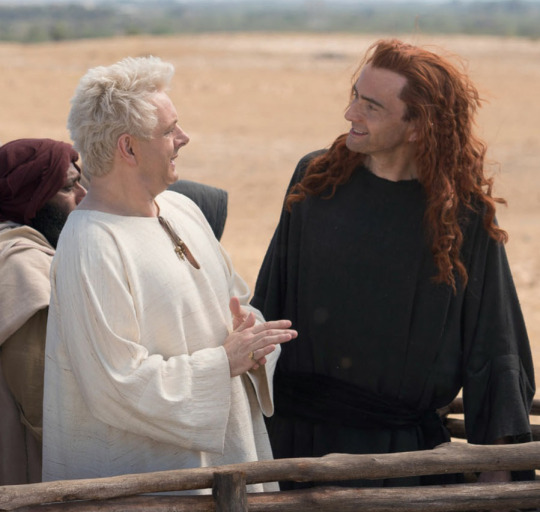
NOAH'S ARK, MESOPOTAMIA, 3004 B.C. - “As aged as I am, I wasn’t there,” Anderson says, laughing. “And there wasn’t any painting or documentation from this era. But what we do know is that tunics remained pretty simple, and the earlier shape would have served them well for many years.” Aziraphale’s robe becomes more streamlined, and he wears gold beads at the neck.
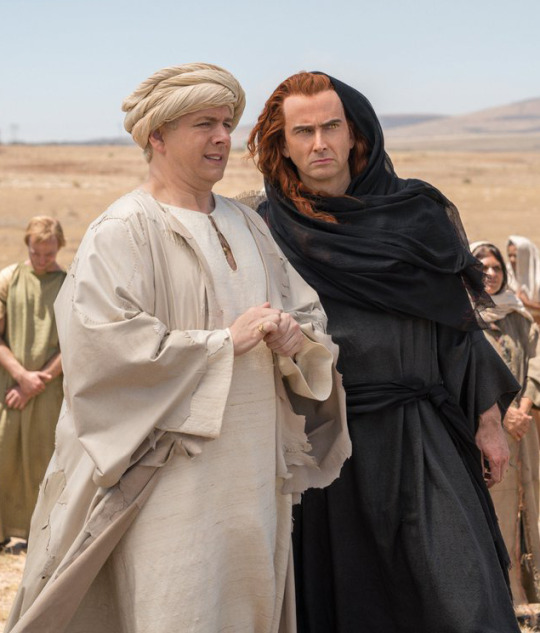
THE CRUCIFIXION, GOLGOTHA, 33 - By this time, both Aziraphale and Crawley — now Crowley — are wearing turbans and head wraps, which Anderson attributes to “a bit of vanity.” Plus the wrap helps Crowley conceal his snake-like eyes (it’s too soon for glasses). Aziraphale dons a soft leather coat over his tunic, while Crowley wears female attire of the region — an abaya.
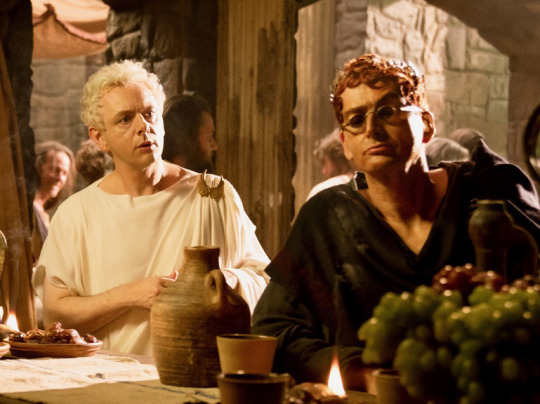
ROME, 41 - Switching from tunics to togas was difficult, since togas contain 6 to 12 meters of fabric, which is a lot to carry around on camera. Anderson reduced the size by cutting the togas to fit for the character’s movements, and she gave each actor a thematic decorative pin to hold their togas together — Crowley a serpent and staff, Aziraphale a pair of wings (both courtesy of George Easton at Danegeld Historic Jewellery). Although history might argue that it’s too soon for sunglasses, Crowley starts to shield his eyes with a very small, eye-shaped lens. “It’s suggestive, rather than historically accurate,” Anderson says. And as a sign that Crowley is adapting to the humans around him, he also wears a silver laurel wreath.
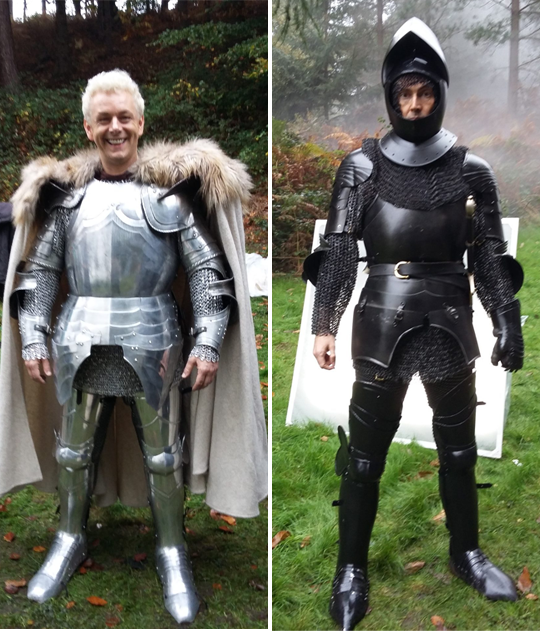
ARTHURIAN ENGLAND, THE KINGDOM OF WESSEX, 537 - Anderson sent character descriptions and visuals for Aziraphale and Crowley to armor specialist FBFX, which sent a van to London full of pieces that could work for angelic and demonic armor. Instead of focusing on historical accuracy, Anderson looked for shapes and fit that suggested an ethereal — or snakelike — quality, once the pieces had been painted black or silver. For Crowley, she found a helmet that had a smaller face that could suggest a snakehead, and for Aziraphale, shoulder pieces that were slightly wing-like. To add to the wing effect, Anderson added a white fur caplet to Aziraphale’s armor. “It was terribly grand, but not very practical,” she says. “And the poor guys, it was murderously uncomfortable to stand around in that armor.”

GLOBE THEATRE, LONDON, 1601 - Crowley and Aziraphale catch an early version of Hamlet, looking more period-appropriate than ever thanks to the Globe’s vast archive of costumes. Aziraphale’s wardrobe, which includes a neck ruff edged with gold thread, has a metallic look with a hint of iridescent blue, which opens up his color palette. Crowley, meanwhile, wears a cleaner neckline and leather on his doublet, as well as fabrics that provide sheen and luster to suggest his snaky origins.
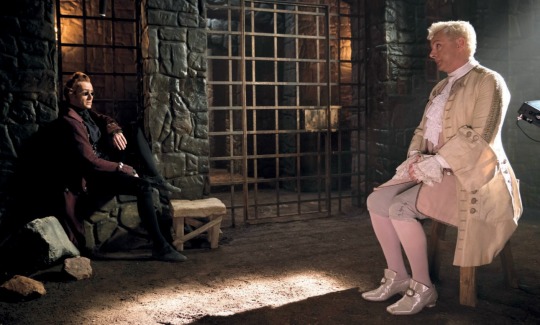
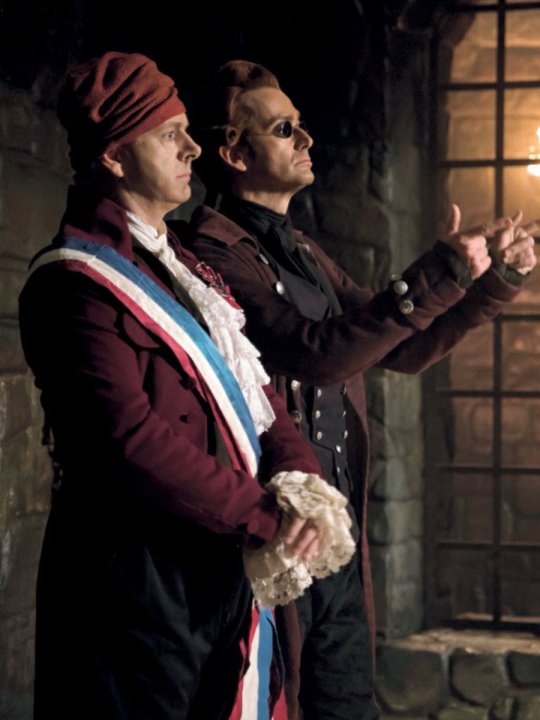
REVOLUTIONARY FRANCE, PARIS, 1793 - This is not a period to be dressed like an aristocrat, but Aziraphale couldn’t resist a lace collar, gold brocade and fitted jacket — which explains why he’s stuck in a prison cell (at least until Crowley intervenes). Crowley, more mindful of what revolutionaries would wear, dons a dark red jacket that’s almost as dark as his usual black. When Aziraphale miracle-changes his clothes, he wears the red cap of liberty. “It’s a soft beret that falls somewhere between a modern French beret and a pirate headdress,” Anderson notes.

ST. JAMES' PARK, LONDON, 1862 - This is the time period with which Aziraphale gets most comfortable, fashion-wise, and settles into a Victorian look with tartan flair. Anderson also bestowed some heavenly nods to his angelic nature — a feathery velvet top hat, a stopwatch with angel’s wings on the chain, and the signet ring. Crowley, meanwhile, wears a pair of long, elegantly cut trousers that we will see again in the 1960s. “The trousers repeat, which is basically what fashion does anyway,” Anderson says. “And it’s what the story does. There are notes backward and forwards.”
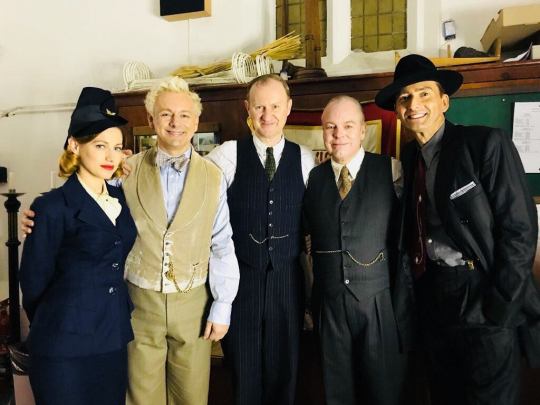

THE BLITZ, LONDON, 1941 - Aziraphale’s tartan necktie becomes a bow tie, and his penchant for wide lapels, a nod to his wings, continues, this time with a spear-point collar. Crowley, who comes to save Aziraphale once again, is dressed more formally, in a full double-breasted wool suit that must have been hard for David Tennant to wear in the South African heat. “The rest of the crew were in flip-flops and T-shirts, and David was in the suit, hat, and those big boots,” Anderson says, recalling the shoot. “He had to be very physically active in that scene, and yet David didn’t complain about the heat or anything. He’s amazing.”

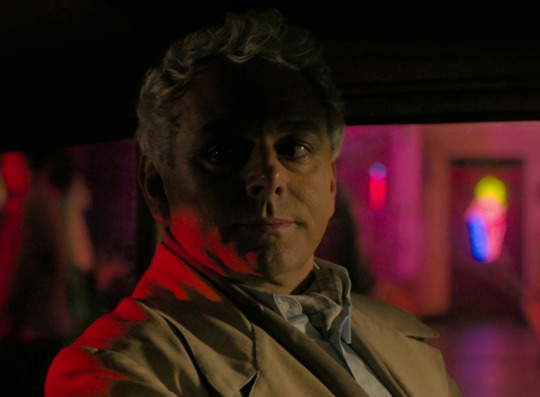
SOHO, LONDON, 1967 - Crowley, as noted, continues to wear his Victorian trousers, which are right up to date, and which he pairs with a black paisley velvet jacket with contrasting lapels. His sunglasses now have more of a John Lennon vibe. Aziraphale, perhaps inadvertently, is also looking stylish with his Victorian topcoat, spear-point collar, and cravat (modified from his scarf in Victorian England). “You can’t avoid being affected by changing trends,” Anderson says. “However bookish you are, you still notice other people. And you would have had Rolling Stones and Beatles fans wearing that kind of thing. That was our argument for Aziraphale wearing his Victorian topcoat all the way through, and Michael Sheen loved it. He said it inspired him. And the cravat rang in the changes and helped us with the passage of time, rather than always having him wear a bow tie.
#good omens#david tennant#michael sheen#ineffable husbands#crowley and aziraphale#claire anderson#long post#tennant tuesday#costume design#apologies for the length of this post#but it was all so darn interesting!#(guess I should have done part 1 and part 2?)#stuff i posted#they put so much thought into everything#I hope they win that emmy!#I'll probably reblog this with the links intact when I get home tonight#because it's killing me to not include the links to these two articles#p.s. I love the bit about david's snake-hipped sexiness#good omens costumes long post
18K notes
·
View notes
Text
Thank You For Ruining My Life: An Homage to Tom Cavanagh
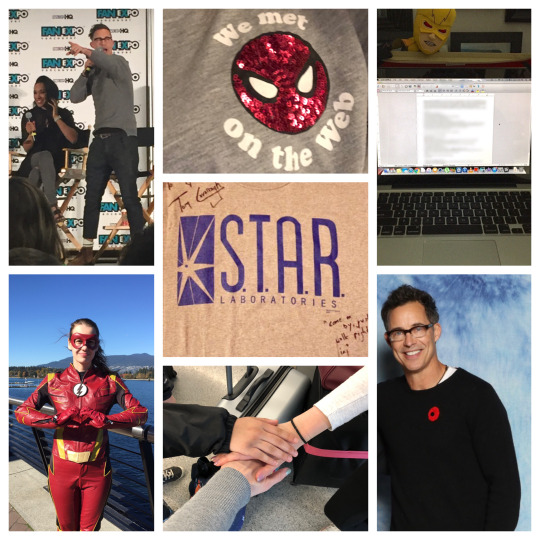
“You’ve ruined all my future expectations of men.”
The costume-clad woman had the courage of steel to say this to the then 53-year-old actor, Tom Cavanagh of The Flash, in front of a ballroom filled with a couple hundred people. This brave utterance was spoken during the 2016 Fan Expo Vancouver convention during a Flash question and answer period with actors Tom Cavanagh and Candice Patton. In its third season, the show was undoubtedly still hitting its stride in popularity, and the room was packed to hear these two speak.
The brave woman whose turn it was at the microphone was referring to Tom’s role as Ed Stevens on the NBC 2000 hit, Ed. I had not known of this show previously, but having now heard such a proclamation intrigued me. “You’ve ruined all my future expectations of men.” That was a tempting notion, and as I continued to listen to this disarmingly charming and wittingly funny man steal the stage, Tom intrigued me even more. I’d watched him play three different versions of Harrison Wells on The Flash since the show’s premiere date, yet I hadn’t truly noticed him in a “life-ruining” way before.
Little did I know that Tom Cavanagh would not only eventually ruin my expectations for men as well, but he would change my life in other ways, too.
After the Q&A, I had this urge to buy a S.T.A.R. Labs T-shirt from one of the vendors at the convention. In my head, I thought I would purchase something so that I could have an excuse to talk to Mr. Cavanagh at his signing booth. Again, he intrigued me, and I wanted to experience more of his incredibly likeable personality. So, I dragged my friend with me to wait for what was maybe ten minutes in a queue. Shortly, I was paying the assistant for my autograph I would soon acquire. They wrote my name on a sticky note so that Tom would know how to sign a personalized message to me. And then, it was my turn.
His eyes sparkled when he turned his attention to me. I instantly had a feeling this was just the way he was naturally. Oh yeah, and I swear to God I’d never seen eyes that blue in my entire life. It genuinely stunned me.
“Hi!” he greeted me.
“Hi!” I responded, equally as thrilled. Tom admired the T-shirt I had brought and took note of my name on the piece of paper. I remember us joking together about the extremely lax security in and around S.T.A.R. Labs on the show, which prompted his message to me on the heather-grey cotton. He wrote my name, [followed by a heart!] and a very welcoming, ‘Come on by, just walk right in!’
I had official clearance from Harrison Wells himself.
I thanked him very much, leaving with my treasure folded over my arms. My friend and I walked towards the hall’s exit, and I couldn’t shake this feeling inside me. It felt strange—I couldn’t name it for the life of me. It felt like an odd fluttering with a simultaneous yet contradictory slightness of breath. My head was confused and would continue to be so for the rest of that weekend.
As I waited at my gate in the airport on that Sunday evening to head home, all I knew was that the moments at the con featuring Tom were the highlights of the weekend for me.
And that I was going to begin watching more of the other films and television shows he’d been in. What was the show the brave cosplaying woman had said ruined her expectations of men? Oh yeah, Ed.
Maybe I’ll start there…
***
Feliz Navidad, Feliz Navidad…
In my house, it’s never really Christmastime until Michael Bublé croons through the speakers of the wooden stereo system in the living room. It felt especially festive as it was now Christmas Eve—a month and some change since the con. It was late, possibly ten o’clock. I was lying on the floor in front of the Christmas tree with my trusty laptop, a word document open. I was writing three holiday-song short stories featuring the new muse in my life, Harrison Wells. I wanted to be able to post them the next day, so my fingers were taptaptapping away.
I had written a handful of things before 2017, most of which had been Marvel-related, under my second, ‘rebirth’ pen name online. I was a little fish among all the grand and fabulous writers on Archive of Our Own, and in many ways, I still feel like that little fish. I was only just learning and feeling out the psyche of the Wells characters. Each one is so different. In my rewatch of the previous seasons of The Flash, I’d taken diligent notes, and as I’d later learn with each following rewatch, I would know them all—what they think, how they talk and behave—like the back of my hand. It was fun to suss out these guys, and I found that I was growing to love the act of writing even more.
One month later, in January, I would post all the stories I’d written thus far on Tumblr. I’d just created an account and, who knows? Maybe I’d get a wider range of readers on here, too.
Might as well give it a shot, right?
***
Wild horses couldn’t keep me from attending Fan Expo Vancouver 2017, especially when the big news dropped. Not only would Tom Cavanagh be attending again, but so would Carlos Valdes, Danielle Panabaker, Candice Patton, and the convention-elusive star of the show himself, Grant Gustin.
Before the moderator for the Flash cast’s Q&A panel could utter the final thanks to the actors at the end of the session, I bounded from my seat and sped down to the photo op booth where the cast would be taking “Team Up” photos with fans. ‘Sped down’ has to be the most appropriate couple of words because I indeed felt like a true Speedster dressed head to toe as the small screen’s adaptation of Jesse Quick, the angsty and brilliant daughter to Harrison Wells turned superhero.
After waiting in a queue that felt like ages, I was next to stand with Team Flash. As I took a step forward, all of the actors’ and actresses’ eyes—the people I spend time with every Tuesday evening—were on me. I heard a familiar voice approve of my costume. It was Danielle.
“Tremendous.”
Grant even joked that he thought for a second Violett Beane, the actress who plays Jesse Quick, had shown up to surprise them. “I was like, what’s Violett doing here?” he said.
I stood in the back row, happily sandwiched between Tom and Carlos. I dared to let my hands rest on their backs, and I couldn’t contain my joy. Shortly after, when I received my near-instant physical photograph of the moment, I saw Tom had pointed at me. In my mind, it felt as if in his gesture, he meant, hey, look at this cool person. Haha. I couldn’t be further from it.
I would go on to further be uncool in public as I later found myself virtually shaking and almost hyperventilating in line for a one-on-one photo op with Tom. The guy dressed as Kid Flash behind me gave me a few encouragements of the “it’ll be okay” variety. As my turn finally arrived, the lovely man of the hour greeted me with a bright smile in recognition of my Reverse Flash T-shirt (I had done a quick change before this photo op because I had worn a Flash T-shirt for a photo with Grant).
“Great shirt!”
The internet comes up with many hilarious and fitting words, but none such so than the term “Cavanarms.” One of the said Cavanarms found its way around my shoulder in such a casual way. My hand rested on his back, and I have told anyone who will listen about how soft his sweater was. What was approximately a five-second interaction will stay with me forever. And to this day, I will always regret how I’m standing beside him in the picture—there’s a distinguishable gap between us. I could have been closer—should have been!—but I like to use the fact that I felt as if I’d combust into flames if I were any closer to the man.
Maybe I’d have another chance to combust later again that day because, believe it or not, this fan hadn’t had enough of seeing Mr. Cavanagh in person. And since he was appearing at the con for this day only, there was no way I was going to squander any opportunities. Besides, there was still one final thing left on my convention docket: the autograph. In my mind, going to get his autograph was an excuse to get to talk to him and simply be in his presence for longer than five seconds. Here, take my money. I’m a sucker, and I’m proud of it. I saved all year for this kind of thing, and Fan Expo has always been my ultimate nerdy Treat Yoself Day.
Plus, this year I came equipped with a question for Tom (something for which I may have prepared a little too far in advance).
“Which of your characters would win in a lawyering battle: Ed or Miles?”
Miles was Tom’s latest character from his newly released project Darrow & Darrow, a fellow lawyer as Ed Stevens (remember, the man who ruins women’s expectations of men?), whom he portrayed almost two decades prior. What I loved about Tom when I got to ask him this was that he was silent for a moment following the question. He was genuinely putting thought into my question. As he pondered, Tom continued to autograph the photo of us together taken mere hours ago.
“Ed. He would wipe the floor with that other guy. Like, Miles is great, but Ed has a rapier-sharp mind, you know?”
I wholeheartedly agreed with his answer and felt relieved inside for some reason. We thanked each other (as politely as two Canadians can) before I left him to pay attention to the next lucky soul in line. I made the mistake of casting my eyes downward at the signed photo.
Tom had signed two little hearts over the I’s in my name. He really needed to stop adding hearts to my things, or I was just going to melt to the floor. In fact, I started to make these strange noises as I tried not to completely maul everyone in front of me while exiting. My friend ushered me as fast as physically possible on our way out of the main hall. One man took one look at me and asked, “Are you okay?”
No.
“Yep!”
The second I made it out of the herd, I broke out into open space. First came the minor hyperventilating. Then came the squealing followed by laughter. Top it off with various fangirlish comments of, “He’s so beautiful!”, “His eyes are so blue!” and “I love him!” and I was probably quite the sight to see (but at a convention, that’s considered normal!). My friend smiled on as she let me express everything that I had to keep inside until I had the right time to expel my emotions. I was on cloud nine. Ten, if at all possible.
The next day would be the con’s final day, which I would attend alone. My friend needed to catch the ferry in order to prepare for her courses the day after. I did a scan of the convention hall one final time in case there was something I missed purchasing. Afterwards, I sat on the cold hard flooring of the convention centre hallway for a bit of a break. I was wiped out. With my phone in hand, I smiled at the messages from this one Tumblr blogger who had been following my posted adventures at the con. I had seen and replied to many of her comments on my stories I’d written thus far, and I enjoyed her matching enthusiasm for Tom and The Flash in general. I felt her to be a kindred spirit. I had no idea then that I was chatting with one of my future best friends, L.
***
I spotted her.
She was wearing an identical shirt to the one I had on—a light grey T-shirt with a sequinned Spider-Man mask in the corner, which around it read, We met on the Web. A giddy me couldn’t wait for the short escalator ride to end. Her back was to me and facing the baggage claim, so here was my chance to surprise her instead.
I towered over my friend, E, and donned a low, authoritative voice.
“Excuse me, Miss, can you come with me?”
She squealed a greeting to me and I returned it as we hugged for the very first time after two and a half years of online friendship. We would still have about two hours to kill until our mutual Tumblr best friend, L, touched down at Chicago’s O’Hare Airport from across the Pond.
Something I noticed was that E and I carried on talking during our wait like it was second nature, that we hung out like this all the time. Whereas when I met L in person for the first time the year previously, our first meeting was that of quiet, delighted shock, unknowing how to react to one another’s physical presence. It almost felt like a fantasy. The closest thing we’d ever gotten to this was visiting over video chats! I’m not sure what each of these different reactions in these separate meetings meant, but what I do know is that I’ve never had such strong female friendships such as these—so full of uplifting support and love for one another. They are the greatest ladies I’ve ever had the pleasure of knowing.
And as a searching L eventually turned the corner to meet us in the Arrivals terminal, I caught sight of her Tom & Grant bandana tied around the handle to her carry-on bag. It was an item she had received in return for helping fund the short film produced in 2018 (I’d bought the ringtone). Seeing the accessory jolted me to remember that the former of the titular short was the reason for this long-awaited get-together holiday in the Windy City in the first place. Tom Cavanagh, unbeknownst to him, had just officially united three online friends, each from a different country, to spend six full days of in-person bonding and a whole lot of fun.
***
I should have been shelving books.
I should have been doing a lot of library-related tasks, but my head was elsewhere. Anywhere other than the small-town public library where I work. Instead, I sat on the carpeted floor of the Junior/Young Adult section with my phone in hand and a dreadful article title staring back at me.
“The Flash: Carlos Valdes and Tom Cavanagh to Exit after 7 Seasons.”
My world felt like it was falling apart.
Tom was leaving? There had been rumours and wonderings spreading around the fandom regarding whether he was leaving the show. With a storyline ending with a monumental sacrifice and a time-travelling man saying his farewells, it all seemed to point to the fact. I should have known… I could have rivalled Supergirl as being the Paragon of Hope after all the optimism I doled out to my followers and friends who would come to me worried Tom would exit the show. I would always give reasons to deny such a thing could happen, claiming that I’d believe when I saw it.
Well, there it was, and I definitely saw it.
One could feel the ripple effect over the internet of the shards of broken and riled-up hearts around the world.
Tom’s exit was on his terms, having not felt challenged by his character’s plotlines, as mentioned in a recent Entertainment Weekly article. As a viewer—and I am a viewer (Mike and Tom Eat Snacks, anyone?), it has been increasingly difficult to look past the missed shots made by story editors and showrunner, so understandably, the actor would want to seek something more exciting and meatier. That said, Tom has always shone on-screen and taken what he’s been given in stride. He turns unearthed material into diamonds and indeed shines on screen. Steals it, even! Tom easily makes the episodes he’s in better, and when he’s missing, you feel the loss. The few episodes of Season 7 without him only give us a tiny hint at how the show will be without him going forward. It much resembles when you might bring out your favourite jigsaw puzzle, only to find that the one piece you need to complete it isn’t there.
***
On a personal note, as I write this, I am roughly 20 followers away from reaching a milestone of 2,000. I have written well over 200 stories for The Flash alone (whether they be short or long, one-shots or chaptered), and goodness knows how many words I’ve generated altogether over the course of these many years with inspiration from the show and my favourite character. I’ve written and co-written novel-length stories, one monumental Wellsian story of which was done alongside L and E (almost solely done through alternating text messaging in the app, Line) that reached over 108,000 words and consisted of 42 chapters. And when I’m not writing for my blog, I’m also working on trying to accomplish my dream of becoming a published author. Just as I thought before I launched my Tumblr blog, I think again now: Might as well give it a shot, right?
***
I have watched virtually everything Tom has been in that I could get my hands on, both physically and electronically. Sure, a few titles are out of my reach and probably lost to the very early 90's forever, but from what I've seen through Tom's filmography is enough to know that he can do anything. He can play the romantic leading man that will make you fall head over heels for him or a deranged killer that will have you genuinely scared of him. That is talent. Tom always brings something new to the table from each role to the next, and (when he's not playing those psycho killers) you can't help but admire his craft.
Not only is his acting stellar, but from what we as fans have gathered on the man, Tom has got to be one of the kindest men in the business. His humour and sheer ridiculousness could get anyone through a tough time (we’ve seen plenty of bloopers and behind-the-scenes videos to prove this!). He has clearly bottled and stored an endless supply of Fountain of Youth™ and each year continues to wow us with his handsomeness. Tom is charming, dedicated, and yes, arguably holds the world record for Bluest Eyes.
In my eyes, Tom Cavanagh gave me the two best friends I could have ever asked for, as well as plenty more lovely friends I’ve continued to make online. (One day, I hope to meet him again so that I can tell him in person how because of him, I’ve met such very important people in my life). Through Tom, I have truly found my passion for writing, and in doing so, segued me to dare to dream of becoming a published novelist. I wholeheartedly believe all of this would not have happened if it weren’t for those first series of events that led me to meet Tom and love and admire him immensely. He is indisputable proof that there are indeed men like him out there. Indeed, he did ruin all of my future expectations of men. He ruined my life in the absolute best way and I am eternally grateful.
I am very much looking forward to what Tom will do next. I think it’s rather needless to say that I will follow him in his career, as he has gained a devoted fan for life. He represents so much to me and so much of it I have gained since meeting him that fateful day, when I thought to myself, Maybe I should buy this T-shirt and get this guy to sign it. Wherever Tom goes in life, I’ll be here to cheer him on.
I have a pretty good feeling plenty of others will, too.
#i don't exactly want to tag this with his name#but this is a personal essay of sorts regarding tom cavanagh's effect on my life#if you decide to read I hope you enjoy it!
51 notes
·
View notes
Text
mutual's post prompted this line of thought, but:
- it was inculcated in me very early on that my appearance--in contrast to most of my relatives'--was unremarkable & also, critically, *unmarked*; this would allow me to be Anonymous & Invisible (the most desirable thing a person could strive for) & pass unnoticed in a crowd. i wasn't tall like my mother, i wasn't dark like my cousins, i wasn't fat like my sister, i didn't "look jewish" & i didn't speak with an accent. at least once a week someone would tell me how lucky i was, how grateful i should be, that i had light eyes & hair, that i had light skin, that i didn't look like the rest of the family. when i hit puberty & my complexion got swarthier, & my hair got coarser & curlier & turned from blonde to nearly black, i gained a lot of weight, & my features got...well, "clockably" jewish-looking, there was much weeping & wailing & gnashing of teeth & rending of garments about it, like, in front of me? about me becoming Ugly & most importantly losing my ability to Blend In.
- like they had counted on me being conventionally attractive to compensate for...everything else, & i grew up to be a chubby jew once hormones hit because everyone in our family is a chubby jew & that's what happens with...genes! & i was being very lightly bullied in school, nothing horrific, just age-appropriate stuff, however, parents projected Big Time & sat me down for these long lectures about Making Yourself A Target & Attracting Attention & It's Your Own Fault For Flying Your Freak Flag Like A Matador To A Bull When You Should Be Perfecting The Fine Art Of Camouflage.
- anyway i'm doing a lot of work rn on the body & interpretations imposed on it against the body-bearer's will during the interwar period & stefania zahorska's descriptions of her self-insert protagonist through her lover's eyes as he means to compliment her beauty by saying she doesn't look jewish at all & she replies something like "close your eyes, unfocus them, & look at my face through the membranes of your eyelids, take in only the forms--the shape of my face, the slant of my eyes, the angle of my nose. & imagine she's a stranger on the street, not your beloved. what would you say now?"
- zahorska was an ardent assimilationist, but she wasn't naive; her response was different, but she, like vogel & schulz, was taking part in a discourse about matter pressed into form by history & i am thinking about this push & pull every day of my life. how do you costume the body to minimize bulk when the personality matches the role but the physicality doesn't, because typecasting shouldn't be Pure Form; how do you cloak your origins in diction & movement & language, in clothing, in style; how is the body obscured by the Subject-Self when we decide the Subject-Self is in conflict with how the body is interpreted by dominant interpretive paradigms, & we make a conscious choice to change others' perception; we impose our will by making others perceive the conjured Subject-Self before they perceive their preconceived notions about the body. it is an act of will, it's an act of self-creation, it's zhiznetvorchestvo!
7 notes
·
View notes
Note
do you think the ages of the actors playing Emma and Knightley respectively have a significant impact on their performances? Like I’m not talking with respect to looks moreso the way they interpret and carry themselves in character. Bc although I haven’t seen all the versions (Kate, Gwyneth) I’ve seen clips of Romola’s after watching Anya’s and couldn’t help feeling that Romola’s gives a much more self-assured and mature version of the role while Anya’s had a streak of brattiness -(1/2)

Firstly, thank you for the ask! I love to receive them, especially discussions like this.
And I think there are probably so many factors at play when it comes to interpretations of the character of Emma (and Knightley) that it is hard to boil it down to one thing such as an actor's age at the time. I would say it is a factor, but I wouldn't necessarily say it is a significant factor. Obviously, casting someone who doesn't look the part (age wise) will affect the audience's believability but an actor's job is to become what is needed. An adaptation of any work is a combination of factors: yes, the actor's vision is one thing, but there is also the script/screenplay, the authorial intent and director's vision that would all contribute to these things. So while Romola and Anya will no doubt have had their own visions of Emma Woodhouse, and some of that would also be down to their age, there would be too many other things happening to say that it would be a significant component - in my opinion.
Personally, if I were to compare 2009 and 2020 (which I am loathe to do because I'm aware it can get heated as to what adaptation is "better" - we all have our preferences and let us leave it there!), I would say that I found Romola's performance more immature. I certainly don't mean that in a derogatory way in the slightest, but (I felt) at least that she had more moments of being silly and childish - with Knightley especially. This may have been in order to make her character more relatable (I do find the 2009 Emma to be too "nice" in comparison to book!Emma - but that's just my personal opinion). I found Anya's Emma to be bratty for sure, but she was very controlled in her performance: her Emma had her own regimented idea of the world and she was very in control of it, and that when things start to go awry for her, she loses the clear assurance she had in herself at the start of the film. This is all symbolised by how perfect everything looked: the sets were like dollhouses, the costumes so precise - so that when we see Knightley losing it after the ball, or Emma getting a nosebleed, these are signs that the picture perfect world around them is no longer within their control. 2009 chose a different path for Emma's journey.
(I don't have time to analyse Kate and Gwyneth's performances here - but each Emma brings something different and I do appreciate that - she is such a layered character that there is always something new to find).
I think Emma Woodhouse is both a mature and immature character for her time period anyway, and that is why she is so complex. She runs her own house and looks after her father - a big role for someone her age, and by all accounts she does this exceptionally well. But she is emotionally immature in other ways: certainly in love and how she treats Harriet, as we know. So I think by saying Emma is either immature or mature is too binary - she is both, she contains multitudes, etc.
So long answer, but I guess in short, perhaps it is difficult for "older" actors to play younger, but if you are good at your job, it shouldn't come into it. I think other factors probably have a more significant impact at the end of the day.
I know I've mostly framed my answer in terms of the character of Emma, and I know you mentioned Knightley too. I guess most of the Knightley's we've had have been age appropriate at the time of casting so it is less of something to analyse. They've all "felt" the right level of maturity which is the most important thing. But again, I think they've all played the role differently but that is more down to the individual whims of the adaptation and script more than anything. Sure, they would all have had some input in their performance too, but there are certain "notes" that Knightley tends to always need to hit and because the book is not from his point of view (mostly), his internal journey tends to be secondary. (2020 really succeeded by virtue of letting him have his emotional journey on screen and that's part of why I adore it so much - he's always been my favourite literary character).
Either way, I'd recommend checking out all the adaptations one way or another - they all give something different and it is fun to see each "spin" on the novel. Even the modern adaptations (e.g.: Clueless, Aisha) give us something new too. I have my own preferences and critiques and thoughts on each, depending on what I personally favour in storytelling. Some are more true to the narrative of the novel, some capture the characterisation more accurately. The beauty of Emma as a book is that it has a lot of nuance and it is fun to see how it can be reinterpreted by different people for different eras and audiences.
#emma (2020)#emma (2009)#jane austen#asks#anon#this isn't particularly articulate and if I had time I'd labour over the ask for hours but these thoughts are just off the top of my head#this is not intended as any slight on any particular adaptation#we all have our favourites and it would be boring if we all thought the same#at the end of the day i will love the book endlessly and will watch every adaptation#because each gives me something new to think about re: the source material#but anyway thank you for the ask!!#emma#text post
12 notes
·
View notes